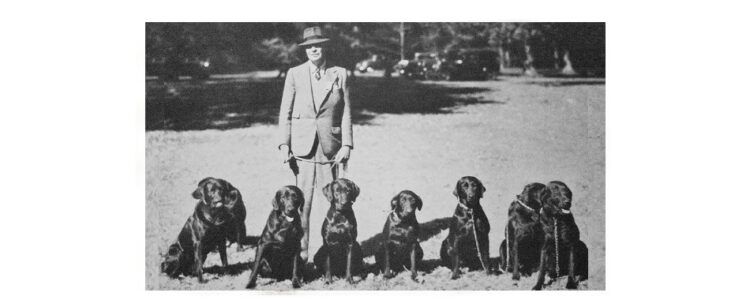
Jay Carlisle (and his Wingan Kennel) was “…undoubtedly the one to whom most credit is due for the rise in the popularity of Labradors in the U.S.A.”
– Labrador Retriever Club Yearbook, 1931-1944
Imagine, if you will, the sprawling mansions, huge parties, and nouveau riche of The Great Gatsby era. The Great War had ended, Prohibition brought speakeasies and organized crime, and the stock market crashed. It is in such a setting we find Jay Carlisle and his Wingan Kennel.
Born in Brooklyn in 1868, Carlisle was a stockbroker and the Governor of the American Stock Exchange during the 1929 crash. His wife was Mary “May” Pinkerton Carlisle. (Yes, that Pinkerton family.)
Carlisle was also a sportsman. His horses ran on the track or competed in shows. He rode to hounds and played polo. And he fished and hunted.
We pick up his story when Carlisle turned his attention to Labrador Retrievers.

Image courtesy East Islip Historical Society – www.eastislip.org
Step 1 – Import the Best Labradors
Jay Carlisle liked a good-looking dog, but he wanted more. He wanted dogs with an acceptable show record and qualified in the field. “Once Mr. Carlisle had decided that the Labrador was to be his breed, he began a study of existing blood lines. He went over countless records, and all the time he had in mind the qualities that he wanted.” 1
After breeding, raising, showing, and racing horses, he developed a discerning eye. However, in the early 1930s, the Lab was still new to America and field trials were just getting started. Carlisle promised to make the breed as popular in America as it was in Britain.
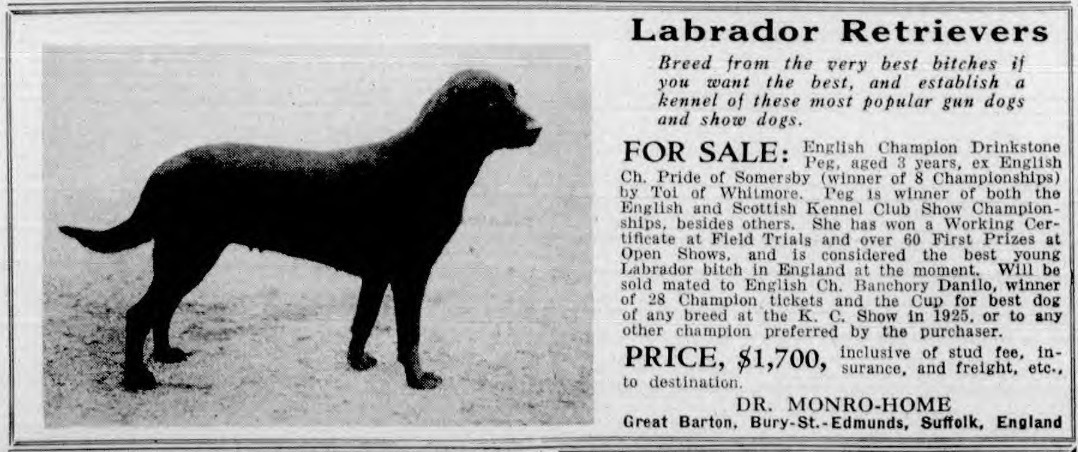
Peg was offered for sale for $1700. Today’s equivalent is about $30,000.
After researching, he imported nine of the finest Labs to start his kennel. The best of these was English Champion Drinkstone Peg of Wingan. She was born in 1927 and bred by Dr GH Monro-Home of Scotland.
Of the other eight Labs, three came from Lorna, Countess Howe.
Eng Am CH Drinkstone Peg of Wingan
Peg was sensational in the show ring and earned nine Challenge Certificates which are similar to ‘winning the points’ in America. Three certificates were enough for a championship, but she kept on winning.
In England there is a ‘show championship’ and a ‘full championship’. A full championship requires the dog to prove it can work in the field as well as win in the show ring. Peg earned her working certificate at the International Gun Dog League retriever trails in 1930 and became a full champion.
She also won her show championship in America. But despite being a top show dog, Carlisle was more interested in Peg’s potential for breeding. Of course the male is also important so he had her bred to Dual Champion Bramshaw Bob. He was one of England’s greatest show dogs and stud dogs.
Two months later Peg whelped seven puppies at Carlisle’s Wingan kennels.
After raising her puppies, she went back into the show ring and continued winning. One of her big wins was Reserve at the Westminster Kennel Club show in 1934.
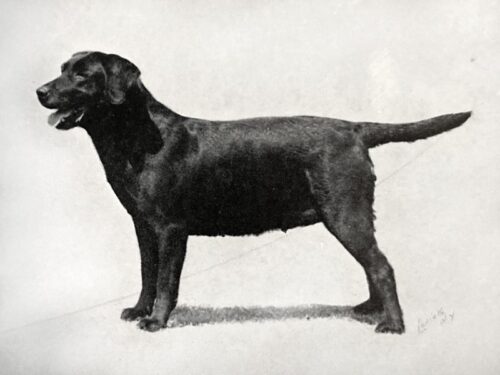
| Eng Am CH Drinkstone Peg of Wingan black female, born 4/18/1927 |
Toi of Whitmore FTW | Tyg of Whitmore |
| Bute of Trentham | ||
| Eng CH Pride of Somersby | Brayton Siddy | |
| Juno of Somersby FTW |
CH Drinkstone Pons
Another dog Carlisle imported was Drinkstone Pons. He was Peg’s son sired by English Champion Banchory Danilo and bred by Dr Monro-Home.
Pons started his show career as a puppy. He won many prizes and was often chosen as the best Labrador, best retriever and/or best gun dog. Pons won Best of Breed at the Westminster Kennel Club show – twice – and also won second in the group competition. He won Best in Specialty Show at the annual Labrador Retriever Club Inc. show.
In 1934 he started running and placing in field trials. He won the Open novice stake the the Brookhaven Game Protective Association trial with kennel mates Night Light and Ben taking second and third. A New York Times reporter said “The placed dogs showed the influence of the highest breeding, combined with thorough training. All the Wingan representatives exhibited intelligence in their hunting, with a minimum of direction from their handler.” 2

| CH Drinkstone Pons of Wingan black male, born 5/11/1931 |
Eng Ch Banchory Danilo FTW | Eng Dual Ch Banchory Bolo |
| Munden Scarcity | ||
| Eng Am Ch Drinkstone Peg of Wingan | Toi of Whitmore FTW | |
| Eng Ch Pride of Somersby |
Drinkstone Mars
Mars was another outstanding dog. He often won in the show ring and earned his certificate of merit under judges Countess Howe and the Honourable Mrs. Hill Wood.
Pons and Mars were littermates and won the brace class together. Mars won the points toward his show championship at the Labrador Retriever Club Inc. specialty show in 1934. And as a dual purpose Labrador, he also won in field trials.

| Drinkstone Mars of Wingan black male, born 5/11/1931 |
Eng Ch Banchory Danilo FTW | Eng Dual Ch Banchory Bolo |
| Munden Scarcity | ||
| Eng Am Ch Drinkstone Peg of Wingan | Toi of Whitmore FTW | |
| Eng Ch Pride of Somersby |
CH Liddly Bulfinch of Wingan
Bulfinch was another import and was bred by H.A. Richardson. He won about 50 times at championship shows and certificates of merit at field trials.
And he won the points at the Labrador Retriever Club Inc. annual specialty show in 1935. This means he defeated the other non-champion males and earned points toward his show championship.
Bulfinch completed his championship with a 4-point win at the Long Island Kennel Club show in May 1936.
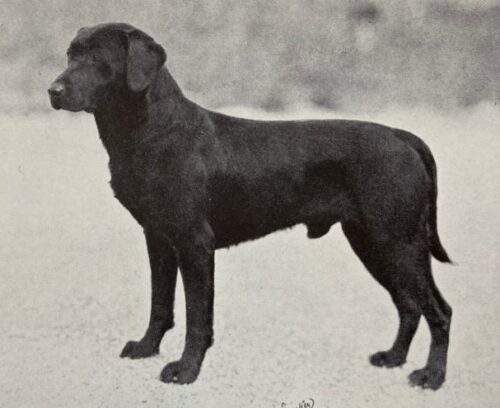
| CH Liddly Bulfinch of Wingan black male, born 2/7/1932 |
Eng CH Tar of Hamyax | Toi of Whitmore FTW |
| Sunshine of Fasham | ||
| Delyn of Liphook | Eng CH Banchory Danilo FTW | |
| Ridgeland Black Diamond |
FC Banchory Night Light & CH Banchory Jetsam
Banchory Night Light and Banchory Jetsam were littermates sired by Blackworth Midnight. They were bred by Miss L. Croad of England.
In 1935 Field and Stream Magazine began offering a challenge trophy to the dog that earned the greatest number of points. Only competition in Open All Age Stakes counted.
Night Light was one of the top Labradors and earned 12 points in the contest. Banchory Varnish of Wingan earned 10 points and Glenairlie Rover was tied with Blind of Arden at eight points.
He was a Field Champion and major pointed in dog shows. Jetsam was a Show Champion which included winning the points at the Westminster Kennel Club show in 1934.
Tops of Bigstone, Night Light’s daughter, produced several quality dogs. These included Dual CH AFC Matchmaker for Deer Creek, FC AFC Ladies Day at Deer Creek, and Kingdale’s Ink Spot.
It’s interesting that Night Light carried the chocolate gene while his sister, Jetsam, carried the yellow gene.
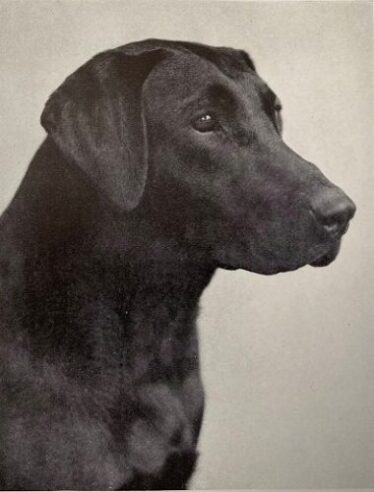
FC Banchory Night Light of Wingan

CH Banchory Jetsam
| FC Banchory Night Light of Wingan black male, born 1/1/1932 CH Banchory Jetsam black female, born 1/1/1932 |
Blackworth Midnight | Eng CH Wilworth Rip |
| Brookstone Jet CCW | ||
| Dinah of Wongalee | Eng CH Beningbrough Tangle FTW | |
| Wendy of Wongalee |
Banchory Dapper
Banchory Dapper was a half brother of Night Light and Jetsam, all sired by Blackworth Midnight. He won a 5-point major at the Labrador Retriever Club Inc. specialty show in 1934.
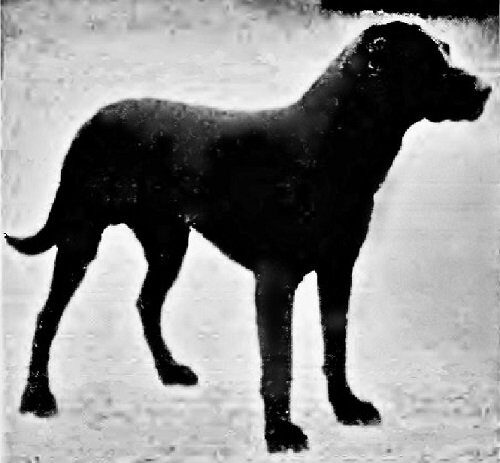
| Banchory Dapper black male, born March 1932 |
Blackworth Midnight | Eng CH Wilworth Rip |
| Brookstone Jet CCW | ||
| Banchory Student | Eng CH Banchory Danilo | |
| Eng CH Pride of Somersby |
Orchardton Doris of Wingan
Orchardton Doris was bred by S.H. Carruthers and worked as a field dog in Scotland.
After coming to America she was described as “a high class bitch with beautiful style, great pace and very keen… She and her handler, Dave Elliot, gave a beautiful exhibition of giving and taking direction to an unmarked fall by hand and whistle, without undue disturbance of ground on either side. She has an invariably excellent pick-up, carry and delivery.” 3
A fast and expert retriever, Doris also had several wins in the show ring.
She was the mother of Pons Junior of Wingan and Wingan’s Daily Double and the grandmother of FC Timber Town Clansman.

| Orchardton Doris of Wingan FTW black female, born 12/31/1930 |
Eng Ch Ingleston Ben | Duke of Kirkmahoe FTW |
| Ingleston Nancy FTW | ||
| Orchardton Dawn | Eng CH Brocklehirst Donner | |
| Hardies Choice |
Eng Sh CH Am CH Banchory Trump of Wingan
The ninth dog, Banchory Trump, stayed in England until he finished his show championship. After coming here, he finished his American show championship with Best of Breed wins at the Westminster Kennel Club dog show and at the Labrador Retriever Club Inc. specialty.
He won numerous Bests of Breed awards and placed in the group several times.
His Best of Breed winning streak included several very competitive shows:
- Morris & Essex, 5/23/1936
- The Labrador Retriever Club Inc, 6/27/1936 – Best In Specialty Show
- Morris & Essex, 5/29/1937
- The Labrador Retriever Club Inc, 6/18/1937 – Best In Specialty Show
- Westminster Kennel Club, 2/10-12/1938
- International Kennel Club, 4/2-3/1938
- Leavenworth Kennel Club, 4/27-28/1938 – Best Of Breed and Group 3rd
- Des Moines Kennel Club, 11/12-13/1938 – Best Of Breed and Group 4th
Trump sired females that passed on excellent genetics. Bred to CH Bancstone Lorna of Wingan he produced Huron’s Lady, the mother of Dual CH Grangemead Precocious. When he was bred to a daughter of Eng FTCh Banchory Varnish of Wingan he produced Peggy of Pheasant Lawn. Peggy was the mother of FC Pickpocket for Deer Creek and Bancstone Dinah, grandmother of NFC AFC Massie’s Sassy Boots.
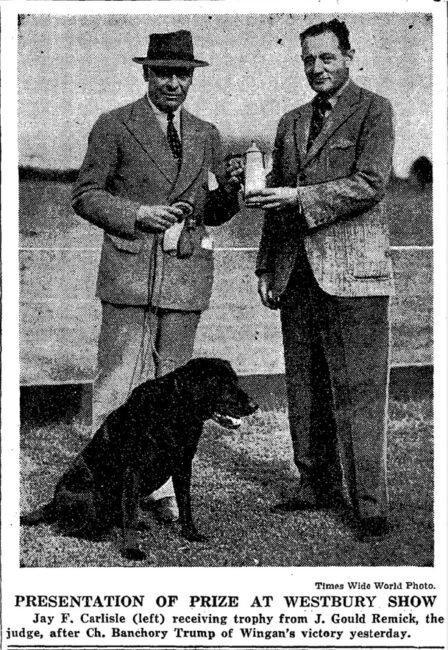
| Eng Sh CH Am CH Banchory Trump of Wingan black male, born 8/21/1931 |
Blenheim Scamp FTW | Balwearie |
| Blenheim Lady | ||
| Lady Daphne | Saffrons Bob CCW | |
| Haste |
Drinkstone Peg’s British litter
Below are Peg’s puppies by Eng Dual Ch Bramshaw Bob.
| Litter bred in England and born in America Born 8/7/1933 |
Eng Dual Ch Bramshaw Bob | Eng Ch Ingleston Ben |
| Eng FTW Bramshaw Brimble | ||
| Eng Am Ch Drinkstone Peg | Eng FTW Toi of Whitmore | |
| Eng Ch Pride of Somersby |
CH Bancstone Ben of Wingan
Owned by J.F. Carlisle
Ben placed in field trials and also did very well in shows. He finished his show championship with multiple five-point majors.
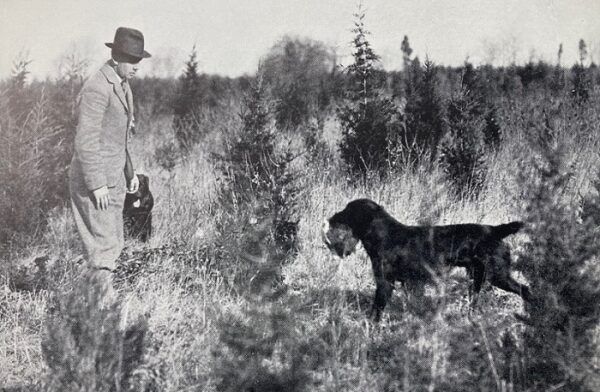
Bancstone Blair of Wingan
Owned by J.F. Carlisle
Although he wasn’t shown much he almost always won his class and even won Best of Breed.
CH Bancstone Bob of Wingan
Owned by J.W. Redmond
Bob also finished his show championship with three five-point majors – including at the Westminster Kennel Club dog show in 1937.
Bancstone Doctor of Wingan
Owned by J.F. Carlisle
Although Doctor was also shown, he didn’t finish his championship.
CH Bancstone Countess of Wingan
Owned by J.F. Carlisle
Countess won Reserve Winners Bitch at both the Westminster Kennel Club dog show and the Labrador Retriever Club specialty show. She finished her championship title with two 5-point and two 4-point major wins.
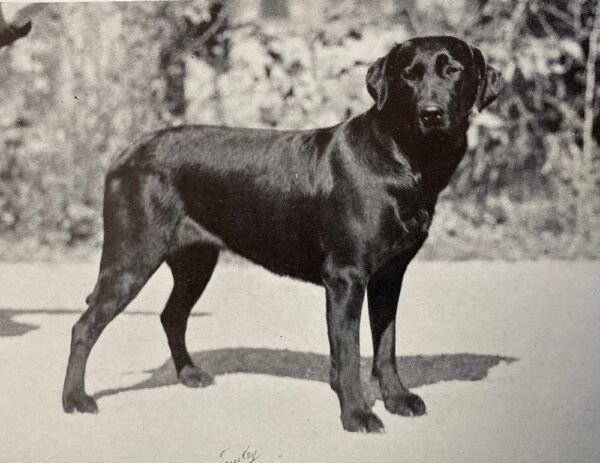
CH Bancstone Lorna of Wingan
Owned by J.F. Carlisle, later by James R McManus
Another Wingan-bred show dog that finished her championship with three 5-point majors. And she won Best in Specialty Show at the Labrador Retriever Club specialty show in 1935.
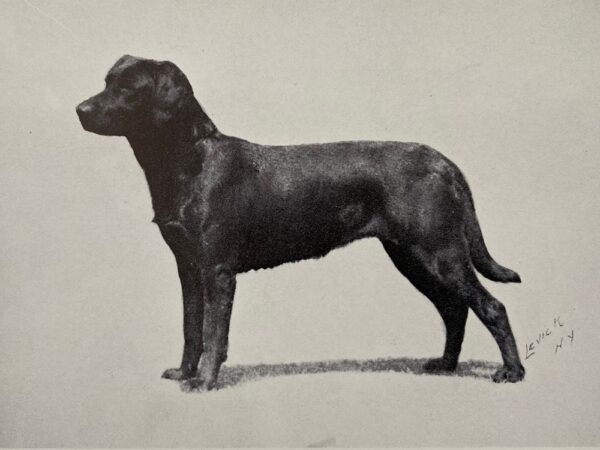
Bancstone Peggy of Wingan
Owned by J.F. Carlisle, later by C.H. Mackay
Although she was halfway to her show championship, it appears she never finished her title.
Other Labs
Carlisle had many dogs – some he bought and some he bred. Here are a few of his better known Labs.
Eng FTCh FC Banchory Varnish of Wingan
Owned by J.F. Carlisle, later by Mrs. Kathleen B. Starr (Timber Town)
In April 1937 Varnish won the Open all-age stake at the Long Island Retriever Field Trial Club. He was described as “consistent in his work throughout a long day … in which champions and top field-trial dogs fell by the wayside.” He “did all that was asked of him in his work on land, quartering, taking direction, showing intelligence in his questing and exhibiting nose for his game.” 4
He also won the Open stake at the Brookhaven Game Protective Association trial in the fall of 1937. “In the second series, his first bird was easy; but the second was dropped across the road in back of motor cars and gallery. The dog worked out the problem, however, and retrieved the bird in grand shape. In the third series, his speed and precision could not possibly escape the notice of the judges while his marking was exceptional.” 5
The gallery cheered their old-time favorite.
Varnish was also pointed in the show ring.
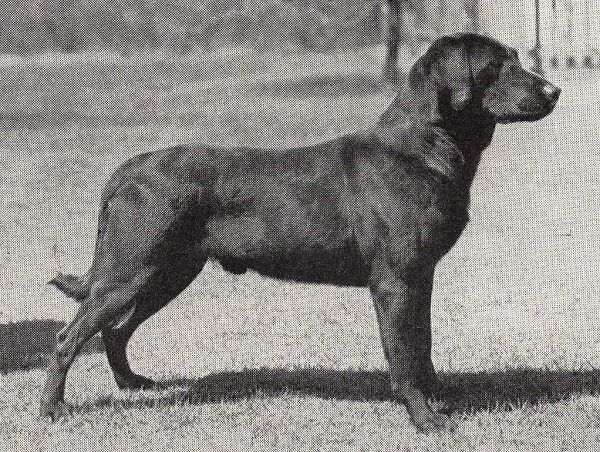
| Eng FTCh FC Banchory Varnish of Wingan black male, born May 1933 |
Eng Dual Ch Banchory Painter | Eng Ch. Peter the Painter |
| Glenhead Bess | ||
| Hawkesworth Glimmer | Banchory Tealer | |
| Bramshaw Gloss |
Pons Junior of Wingan
Pons Junior won the Brookhaven amateur trial handled by Mrs. Kathleen B. Starr (Timber Town kennels). He was described as making “two grand retrieves in the water test, going out on a surveyor’s line to both ducks.” The stake was judged by Colonel the Lord Vivian, D.S.O., of Britain, and David Wagstaff of Tuxedo Park, NY. 6
He also did well in the show ring including winning Reserve Winners Dog at the Westminster Kennel Club dog show in 1937.
A year later Timber Town Clansman, his two-year-old son, won the Women’s Field Trial Club non-winners stake.
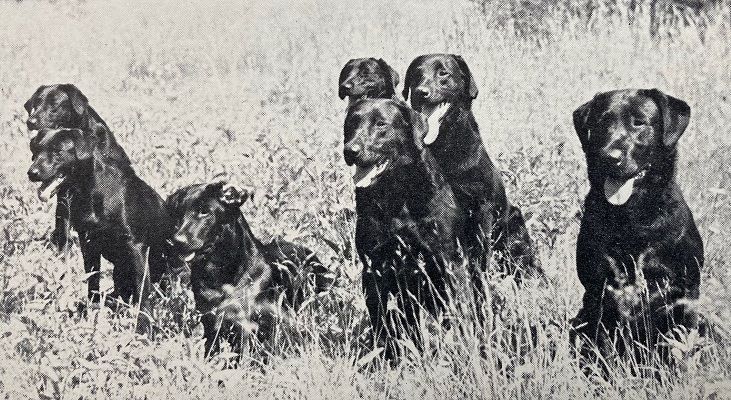
Rear, left to right: Pons Junior, Ebony of Barrington, Banchory Night Light, CH Drinkstone Pons. Front: Whitecairn Wendy, Banchory Varnish, CH Bancstone Ben.
| Pons Junior of Wingan black male, born 4/30/1934 |
Drinkstone Pons of Wingan | Eng FTCh Banchory Danilo |
| Drinkstone Peggy | ||
| Eng FTW Orchardton Doris of Wingan | Eng Ch Ingleston Ben | |
| Eng FTW Orchardton Dawn |
Okanagan Sandy
Sandy was bred in Canada and was special enough to earn a place at Wingan Kennels. One of the field trials he ran was under particularly difficult conditions.
“Six dogs were called back for the final elimination with the sea pounding on the outer bars, whitecaps making in the inlet and snow squalls driving inland. Dog after dog was sent into the icy water. Suddenly the black clouds closed down and the whole world was shut out by a driving snowstorm….
“Sandy’s water work was little short of perfection, he taking to the water with a huge splash, after having marked his two falls…” 7
| Okanagan Sandy black male, born 4/5/1934 Bred by R. Leckie Ewing, Canada |
Beaver of Bryn | Banchory Jock |
| Munden Stigma | ||
| Gay’s Vesta | Eng Nat’l FTCh Beningbrough Tanco | |
| Eng FTCh Vidi of Adderley |
Okanagan Tanco
Tanco was another import from Canada. In November 1936, he won the Derby stake at the Labrador Retriever Club trial in Peapack, NJ.
As the winner, he brought home the directors’ trophy and $25. Although that doesn’t sound like much it’s the equivalent of over $500 today.

| Okanagan Tanco black male, born 6/17/1935 |
Okanagan Rusty | Beaver of Bryn |
| Okanagan Gyp | ||
| Gay’s Vesta | Eng Nat’l FTCh Beningbrough Tanco | |
| Eng FTCh Vidi of Adderley |
Orchardton Duce of Wingan
Owned by Jay Carlisle, later by Mrs Eleanor F. Remick
Duce won the Labrador Retriever Club’s Derby stake at 14 months old. Colonel the Lord Vivian, D.S.O., of Cornwall, England judged together with Dr. Samuel Milbank and Francis Squires. The trial was held at Shinnecock Hills in Nov 1937.

| Orchardton Duce of Wingan black male, born approximately Sep 1936 |
Eng Ch Orchardton Donald | Eng Ch Ingleston Ben |
| Orchardton Dawn | ||
| Mona Of Ammurrness | Eng FTCh Tag of Clava | |
| Queen of the May |
Whitecarin Wendy of Wingan
Owned by Jay Carlisle
Wendy won the Open stake at the Brookhaven Game Protective Association field trail in 1935. The weather was described as “almost ideal, the thermometer hovering around the freezing mark, and the wind was just strong enough to make it a sporting proposition for guns and dogs.” 8

| Whitecarin Wendy of Wingan black female, born approximately 1933 |
Ranger of Kentford | Gift of Halleaths |
| Kirkbean Gyp | ||
| Lochar Kate FTW | Eng Dual Ch Banchory Bolo | |
| Murrayfield Bet |
Wingan’s Daily Double
Another Wingan dog deserving of mention is Daily Double. Bred by Carlisle and sold to Howes Burton, an amateur, who handled her himself. She won at the Long Island Retriever Field Trial Club in 1939 and placed second in what was called “fast company” just a week before. The winner in that trial was Earlsmoor Moor of Arden.
However what makes her special is the combination of pedigree and offspring. She was a half-sister to Blind and Decoy of Arden on her father’s side. And a half-sister to Pons Junior on her mother’s side.
When bred to Eng FTCh Glenairlie Rover, she produced Mint of Barrington who in turn sired NFC AFC Marvadel Black Gum “Blackie”.
Blackie was High Point Derby dog in 1946. He won his first Open stake at 16 months of age and finished his field championship the next year. And he qualified for eight consecutive National Opens (1946-1953), winning in 1949.
| Wingan’s Daily Double black female, born 7/9/1936 |
Odds On FTW | The Favorite FTW |
| Jest | ||
| Orchardton Doris of Wingan FTW | Eng CH Ingleston Ben | |
| Orchardton Dawn FTW |
Step 2 – Build the Best Kennels
Instead of a heated kennel building with attached runs, Jay Carlisle built condos for his Labs. He felt it would be hard for the dogs to go from a heated kennel to retrieving in icy water.
Each condo was 6×11 feet, made out of redwood and set on 4x4s to avoid rot. Inside were two rooms – a 5×6 foot vestibule that became a shaded porch in summer and a 6×6 foot sleeping compartment with a hallway to avoid drafts.
They even had lights, windows and a hinged roof for cleaning.
The condos were set in 20×30 foot concrete runs with trees for shade. Puppies had a similar set up in a larger grass run.

Nearby was the feed house where they stored supplies and prepared meals for the dogs. Puppies were fed five meals a day – cereal with milk in the morning, cooked beef, raw beef, milk and biscuit and a big-dog meal.
Adult dogs got cooked meat twice a week with commercial food, cod liver oil and yeast. Occasionally they got salmon or raw beef.
Step 3 – Import the Best Help
While Jay Carlisle was looking for the best Labs, he was also looking for someone to train the dogs. For that he looked to Scotland where many men learned the business as kennel men and game raisers.
With the help of Countess Howe and many others, Carlisle found the right man. In 1934 he brought David D. Elliot to Long Island from Scotland.

A few months later at the Brookhaven Game Protective Association trial they swept all three places in the open novice stake. Drinkstone Pons of Wingan won $50 for first place. That’s over $1000 in today’s currency. Second place and $30 to Banchory Night Light of Wingan. Third place and $20 to Bancstone Ben of Wingan.
Carlisle did indeed find the right man to run his kennel.
David D. Elliot
Elliot grew up near Edinburgh, Scotland, where he learned about sheepdog trials from his grandfather. Watching how the sheepdogs responded to signals gave him the idea to teach signals to Labs. A form of these signals is still used today to guide dogs on blind retrieves.
Lady Howe, Dr. Monro-Holm and David Black (breeder of Peter of Faskally) recommended Elliot as a kennelman for Carlisle. Elliot agreed to come for five years, but instead, he stayed for a lifetime.
In addition to training dogs, he also trained people. They included Dorothy Howe (Rupert), Joan Redmond (later Joan Reed, Chidley) and Kathleen Starr (later Mrs Fredricks, Timber Town). The ladies were sometimes called “Elliot’s Harem.” Cotton Pershall was another person who learned how to handle dogs at Wingan.
Carlisle was pleased with Elliot’s training and thanked him for introducing him to field trialing. The competition made him happy despite the recent death of his wife.
If you’d like to see Elliot and two of his retrievers – Eng FTCh FC Banchory Varnish of Wingan and FC Timber Town Clansman – check out the “Sky Game” video, filmed in 1939.
Step 4 – Promote the Kennel and Competition
Jay Carlisle registered Wingan as his kennel name in 1933.
He ran ads in a variety of magazines – from the AKC Gazette to Vanity Fair.

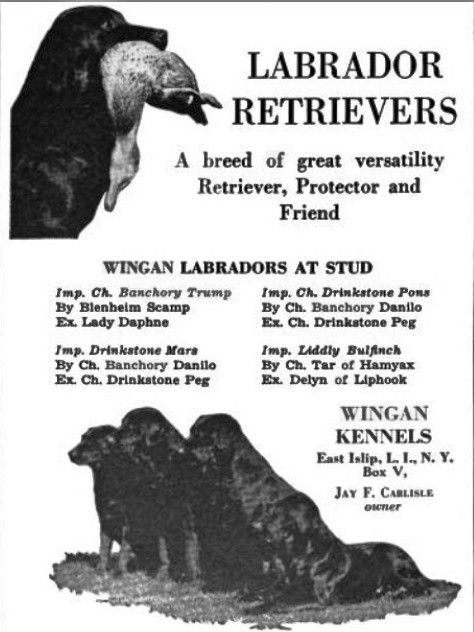

He served as President of the Labrador Retriever Club from 1935-1938. During that time he established the Amateur stake and donated a perpetual trophy so the stake would continue.
Carlisle, Anthony Bliss, Franklin Lord, Gould Remick, Henry Root Stern, and Leonard Buck formed the Long Island Retriever Trial Association. The club’s purpose was to encourage the breeding, training, and use of retrievers, and for holding of all-breed retriever trials.
David Elliot wrote a book about Labs and training them and Carlisle published it in 1936. It included training advice and many photos of Wingan Labradors.
“The efforts and absorbing interest of J. F. Carlisle, his participation in trials and at shows, and his generous offering of dogs at stud to new breeders gave the breed a tremendous push forward in this period. He helped to form a nucleus of good material to build upon, together with the superb group of imports… All this gave the breed the right start, and it was not long before history repeated itself, so that the Labrador was on its way to overtaking all the other Retriever varieties in the New World, as it had in the Old.” 9
The End and a Beginning
Jay Carlisle died in 1937, just eight months after his wife.
He was so respected, that 28 prominent men volunteered to act as pallbearers. A special train transported guests from Penn Station in New York City to Carlisle’s home in East Islip, Long Island.
The retriever community postponed a field trial so contestants could attend his funeral. However the postponement meant the trial had to be limited in order to finish in one day. This was the start of Limited All-Age stakes.
The Labrador Retriever Club, Inc. set up a Jay Carlisle Memorial Trial. It was held from 1938 to 1941 near his home on Long Island. Mrs. Hill-Wood, Morgan Belmont and Robert Morgan judged the first Memorial Trail.
On a sad note, the contents of his home went to auction in 1938 and his beautiful mansion was demolished in 1940.
Most of his dogs were given to the young Scotsman, David D. Elliot. He also received the specially-modified green and yellow dog wagon and the right to rent the Wingan kennel at a reduced rate.
Although it seems like a sad ending, the dogs did continue competing with Elliot. And many people recognized Carlisle’s contribution to Labradors and to field trials in America.

David Elliot (right) with Banchory Night Light winning the Field & Stream Challenge Cup for Outstanding Retriever of 1937.
Today
Few people recognize the Wingan name today or they confuse it with Helen Ginnel’s Whygin kennel. But Carlisle’s efforts – importing quality dogs, making his stud dogs available, and promoting Labradors – helped make the breed as popular in America as it was in England.
I’m proud to have several dogs that trace back to the Wingan Labradors.
— Chip and his descendants trace to –
* NFC Banchory Night Light of Wingan (grandsire of Dual CH Matchmaker for Deer Creek)
* Am Eng CH Banchory Trump of Wingan (grandsire of Dual CH Grangemead Precocious and FC Pickpocket for Deer Creek)
* CH Bancstone Lorna of Wingan (granddam of Dual CH Grangemead Precocious)
* Penney of Wingan (dam of NFC AFC Massie’s Sassy Boots)
— Dee and her descendants trace to –
* CH Banchory Jetsam
* NFC Banchory Night Light of Wingan (grandsire of Dual CH Matchmaker for Deer Creek)
* Am Eng CH Banchory Trump of Wingan (grandsire of Dual CH Grangemead Precocious and FC Pickpocket for Deer Creek)
* Eng FTCh FC Banchory Varnish of Wingan
* CH Bancstone Lorna of Wingan (granddam of Dual CH Grangemead Precocious)
* Bancstone Blair of Wingan (grandsire of NFC NAFC CFC Major VI, 1993 Hall of Fame)
* CH Bancstone Peggy of Wingan
* Eng Am CH Drinkstone Peg (dam of the Bancstone litter by Eng Dual CH Bramshaw Bob)
* Orchardton Doris of Wingan (dam of Pons Junior Of Wingan and Wingan’s Daily Double)
* Pons Junior of Wingan (sire of FC Timber Town Clansman and great grandsire of NFC Dual CH CFC Bracken’s Sweep)
* Wingan’s Daily Double (granddam of NFC AFC Marvadel Black Gum)
Notes:
[1] Arthur Frederick Jones, “True Labradors and Traditions Live at Wingan,” American Kennel Gazette, February 1934
[2] Henry R. Ilsley, “Carlisle’s Entries Take All Three Places in Open Novice Retriever Stake,” New York Times, December 29, 1934
[3] Helen Warwick, “The Complete Labrador Retriever” (New York: Howell Book House, 1965), 137
[4] Staff correspondent, “Carlisle’s Labrador Beats 22 Dogs in Long Island Retriever Clubs Trial,” New York Times, April 18, 1937
[5] Ned Corey, “Banchory Varnish of Wingan First in Brookhaven All-Age,” American Kennel Gazette, December 1, 1937, 94
[6] Staff correspondent, “Brookhaven Field Trials Are Marked by Splendid Work and Keen Competition,” New York Times, October 31, 1937
[7] Henry R. Ilsley, “Retriever Laurels Annexed by Carlisle’s Dog at Trials Held in Snowstorm,” New York Times, November 29, 1936
[8] A.F.J., “Whitecairn Wendy of Wingan Wins Brookhaven’s Open Stake,” American Kennel Gazette, January 1, 1936, 168
[9] Warwick, “The Complete Labrador Retriever,” 126
Glossary:
- AFC – Amateur Field Champion
- Best of Breed – At a dog show, the dog that has defeated all the other dogs of its breed.
- Best of Opposite Sex – If a male dog wins Best of Breed, the best female wins Best of Opposite Sex, and vice versa.
- BLF / BLM – Black Labrador female or black Labrador male
- Brace class – Two dogs shown together that look very much alike.
- CCW – British Challenge Certificate winner (show win, but not a title).
- CH – Dog show championship
- Dual Champion – A dog that has won a show championship AND a field championship.
- English show champion (“Eng Sh CH”) – A dog that earned a show championship, but lacks the working certificate to be a full champion.
- FC – Field Champion (British FTCh) – A dog that has won enough in field trials to qualify for the field champion title.
- FTW – Field trial winner (not a title)
- Full champion – England requires Labradors to pass a working test in addition to earning a show championship.
- Major points – In the US, Winners Dog and Winners Bitch can each receive points based on the number of dogs defeated. It can be 0-5 points, with 3 to 5 point wins called “majors.”
- NFC – National Field Champion
- QAA or *** – A dog that has proved himself in the Qualifying stake and could enter the limited Open or Amateur stakes.
- Reserve Winners – The second best dog of its sex that has not completed a show championship.
- Winners (also Winners Dog or Winners Bitch) – In the show ring, males (“dogs”) compete against other males in various classes. Then the winner of each class competes against the other winning males for Winners Dog. Depending on the number of males defeated, the Winners Dog will receive up to 5 points towards his show championship. It works the same for females.
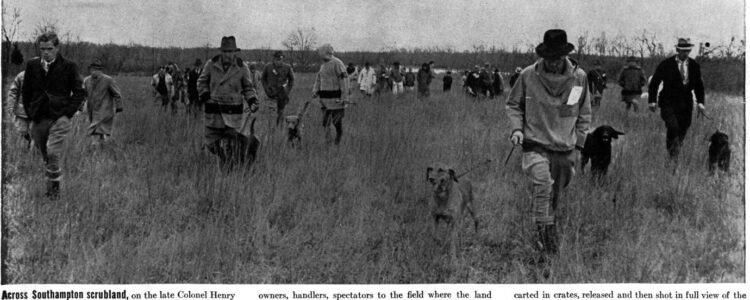
The first championship stake was held in Southampton, Long Island on November 20-21, 1938. Blind of Arden was one of twenty-two of the best retrievers in the US came to compete. They retrieved pheasants shot in the field and ducks shot over water. The dogs saw some birds shot while other birds were planted out of sight. Dogs had to be guided by their handlers to find these birds.
In the header image, you can see the judges, owners, handlers, spectators and dogs trudging across the field trial grounds. 1
The Winner
One dog, FC Blind of Arden did the work without a mistake. He clinched the win with the final blind retrieve described as follows:
“…a dead duck, unseen by the dogs, was planted on an island. At a signal from his handler, Blind jumped into the water and swam to the island. There he scented the bird, looked back only twice to the handler, who with his arm waved him in the right direction. Quickly finding the duck, Blind picked it up with a firm mouth, started swimming back to his handler.” 2
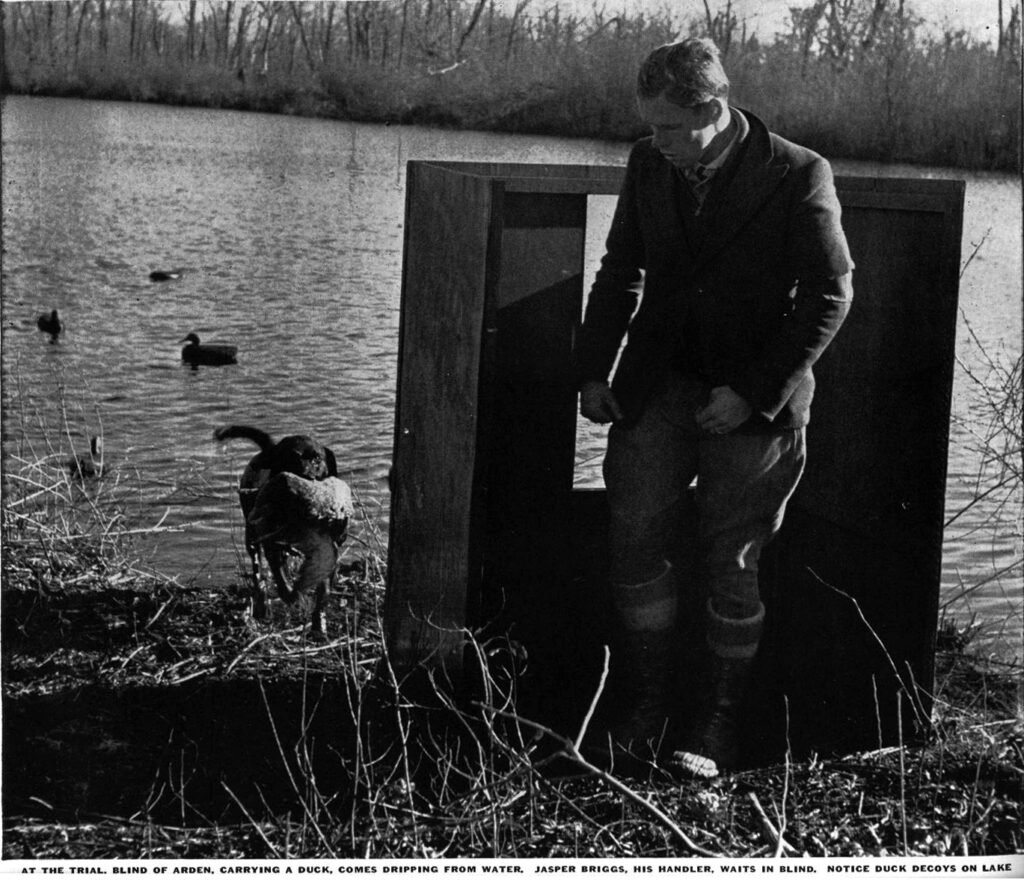
Blind retrieving a duck to his handler, Jasper Briggs.
Life Magazine featured Blind on the magazine’s cover on December 12, 1938. This was the first time a dog had ever been on the magazine’s cover.
US Field Trials
The Labrador Retriever breed was just getting started in the United States and had only been officially recognized by the America Kennel Club five years earlier.
The first retriever field trial was held in 1931. In 1935, Field and Stream Magazine provided a perpetual trophy that would be awarded each year to the dog that earned the most points in Open All-Age stakes. Blind of Arden won it the first year and his half-sister, FC Tar of Arden, won it a few years later. It was 1941 before the National Retriever Field Trial Club was formed.
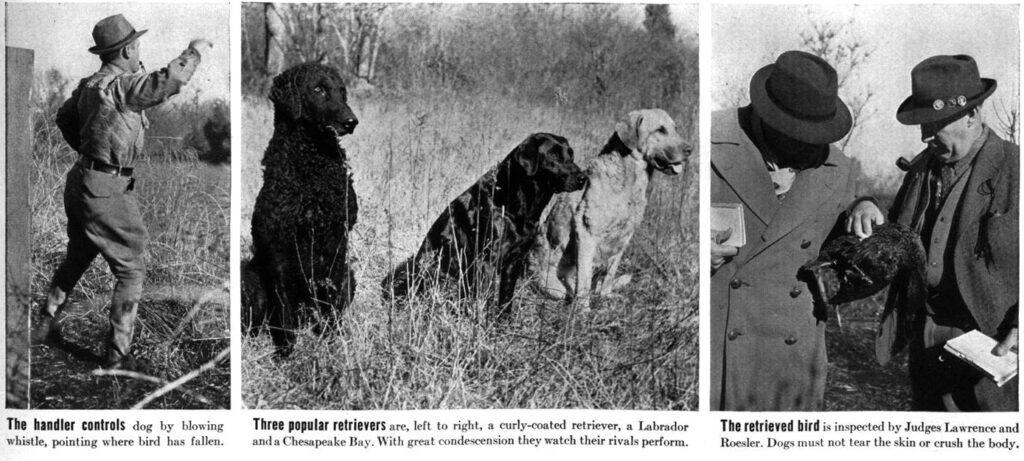
(left) A handler controls the dog using whistle and arm signals.
(center) Three retriever breeds – a Curly coated retriever, a Labrador and a Chesapeake Bay retriever.
(right) Judges inspect a retrieved bird. Dogs must hold them firmly, but gently so as not to break the skin or crush the bird. After the trial, the birds are sold.
At that time, retriever trials were the realm of the very rich. Owners imported dogs from England, enticed dog trainers from Scotland and set up amazing hunting estates on the east coast. To have a chance of winning the Field and Stream trophy, dogs had to run in many trials throughout the East and Mid West.
Blind’s owner was W. Averell Harriman of New York. He was the son of a railroad baron and, in his own career, he served as Secretary of Commerce under President Truman, served as a diplomat in relations with the Soviet Union during World War II and later served as governor of New York.
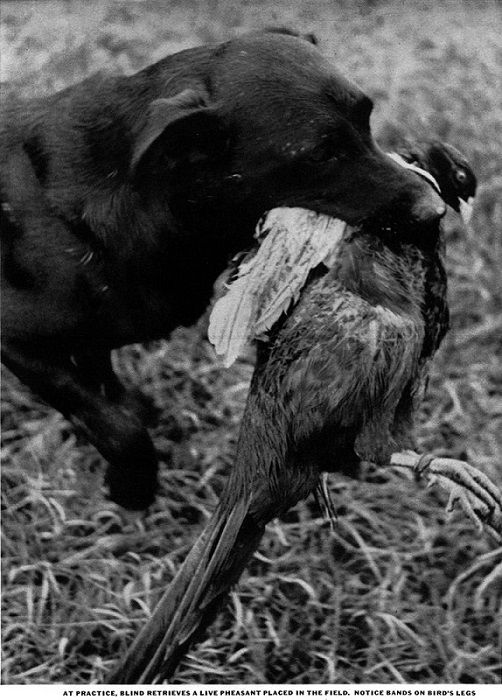
Blind of Arden training with a live pheasant.
Blind of Arden’s Pedigree
| Odds On FTW | The Favorite FTW | The Limit |
| Cache Of The Rhins FTW | ||
| Jest | Mansel’s Timothy | |
| Bess | ||
| Peggy of Shipton FTW | Ronald of Candahar | Eng FTCh Rag Tag |
| June | ||
| Gehta of Sigeforda | Eng FTCh Banchory Bluff | |
| Eng CH Balbeardie FTW |
Although Blind didn’t seem to produce any titled dogs himself, he did pass on his genetics to future generations. Some dogs that descend from him include:
- CNFC FC AFC Ardyn’s Ace of Merwalfin
- Eng FTCh Eng AFTCh Slo-Poke Smokey Of Dairy Hill
- FC AFC Jet of Zenith
- CNFC FC Rip of Holly Hill
Blind’s great great grandson
Jet of Zenith’s pedigree is interesting.
| NFC AFC Massie’s Sassy Boots Hall of Fame |
Shadow II | Black Spook of Riverside |
| Dark Lady | ||
| Penney of Wingan | Darky of Wingan | |
| Bancstone Dinah | ||
| Thornwood Rhea | CNFC FC Rip of Holly Hill | Skip of Timber Town |
| Okanagan Molly (by Varnish’s Tuff, out of Marjay of Wingan, by Blind of Arden) | ||
| Graysmarsh Christmas | 3xNFC CFC Dual CH Shed of Arden | |
| Graysmarsh Middy (by Blind of Arden) |
Starting at the bottom of the pedigree, Blind’s daughter, Graysmarsh Middy, was bred to her cousin, 3xNFC CFC DUAL CH Shed of Arden, thus doubling up on Peggy of Shipton.
A female from that litter, Graysmarsh Christmas, was bred to CNFC FC Rip of Holly Hill. Rip was a great great grandson of Blind through Okanagan Molly, thus doubling up on Blind.
A female from the Rip x Christmas litter, Thornwood Rhea, was bred to NFC AFC Massie’s Sassy Boots. Boot’s mother, Penney of Wingan, had several lines back to Eng DUAL CH Banchory Bolo and other dogs owned or bred by Lorna, Countess Howe.
Read more about the Wingan Labradors.
Blind’s sisters
Then there was Blind’s full sister – FC Decoy of Arden – who was an outstanding producer. She was the mother of:
- 3xNFC CFC DUAL CH Shed of Arden,
- DUAL CH Braes of Arden,
- DUAL CH Gorse of Arden,
- CH Earlsmoor Moor of Arden,
- CH Earlsmoor Marlin of Arden (all by CH Raffles of Earlsmoor) and
- FC Gun of Arden (by Toff of Hamyax FTW)
And Blind’s half-sister – NFC Tar of Arden (by Hiwood Risk) – who was the mother of Dual CH CFC Little Pierre Of Deer Creek.
(Click for help understanding the various titles dogs have earned)
Arden Labradors
Blind was bred and owned by Mr. Harriman.
“According to Bob Bartos, ‘Harriman had some of the greatest Labradors. His Arden dogs were bred from the best English stock and they became the first important competitive winners…’
“Harriman knew quality, played to win, and possessed the financial resources to kick out the jams. For members of his elite social class, shooting and sport hunting were revered pastimes. Harriman hunted grouse at Arden and Sun Valley, two of his personal estates, and he never missed the British shooting season. This is where he first glimpsed Labradors in action. He was awestruck.” 3
First National Field Champion Blind of Arden
Whelped: March 20, 1933
Breeder/Owner: W. Averill Harriman, Arden Kennel
Registration: 965,612
Abbreviations:
AFC – Amateur field trial champion
CFC – Canadian field trial champion
CNFC – Canadian national field trial champion
Dual CH – Dual champion (show and field champion)
Eng AFTCh – English amateur field trial champion
Eng FTCh – English field trial champion
FC – Field trial champion
FTW – Field trial winner (not a title)
NFC – National field trial champion
Notes:
[1] Blind of Arden Wins No. 1 U.S. Retriever Test. (1938, December 12). Life, 5, 26–27.
[2] Ibid
[3] Fernandez, Amy. Retriever Field Trials – The Early Days. Canine Chronicle. 2020, Aug 26. 2024, May 21. https://caninechronicle.com/current-articles/retriever-field-trials-the-early-days/
Originally published September 17, 2021. Updated May 21, 2024.
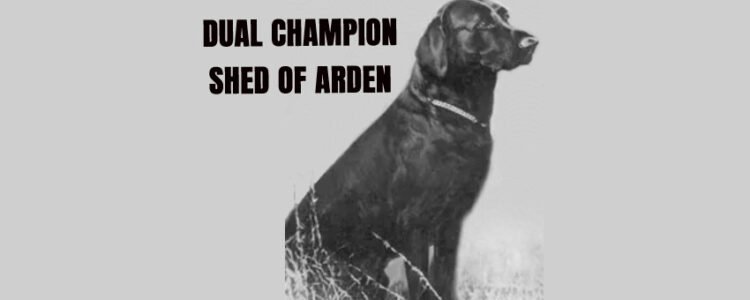
“Shed of Arden’s qualities were of the highest: he epitomized an ideal.
…By those who are knowledgeable, he was considered to have embodied the greatest qualities a Retriever can possess in equal parts: looks, performance, and the priceless gift to transmit these from generation to generation.”
~ Helen Warwick, Lockerbie Labradors
Shed of Arden’s story
3xNFC CFC DUAL CH Shed of Arden is one of the best-known Labrador Retrievers in history, but what do we know about him and his family?
Shed was born March 26, 1939, and bred by William Averell Harriman who owned Arden kennels. Paul Bakewell III of Deer Creek Kennels bought Shed as a young dog.
There’s a story that his siblings were all named for fish and that he was supposed to be Shad of Arden. Due to a clerical error he became Shed instead.
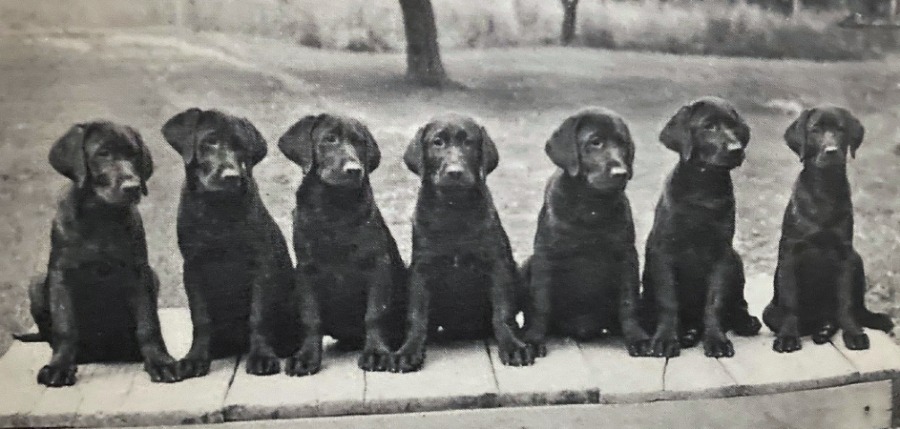
The Arden ‘fish’ litter, including Shed, Bass, Marlin, Trout.
Competition
Show competition
Although Shed often competed in the show ring and field at the same time, he started his career in the show ring. At 14 months old he won Winners Dog and Best of Winners for a 5-point major at the Labrador Retriever Club’s specialty show in 1940. His older brother, CH Earlsmoor Moor of Arden, won Best in Specialty at that show. A week later the brothers repeated their wins at another show with another major for Shed.
He finished his show championship 15 months later with two Best of Breed wins and a Group 4th.
Field Competition
Retriever field trials in America were still in their infancy when Shed was born. It was only nine years since his uncle, NFC Blind of Arden, won the first field trial.
Shed started his field career with a Derby second at 20 months, still owned by his breeder.
The next year he started earning points in field competition. By the fall of 1942, he had finished his field championship to become a dual champion. He also qualified for the National Retriever Championship.
National Championship 1942
As a 3-year-old, Shed won his first National Championship. He was handled by Lt. Bakewell who was on leave from the Navy Air Corps.
Madison, Wisconsin hosted the National on December 4-6, 1942. The weather was cold. “The Yahara River and adjoining marshes which ordinarily afforded everything desired for water tests were frozen solid…. This necessitated moving the water tests to the University of Wisconsin property along the shores of Lake Mendota. Heavy ice floes made it dangerous for dogs to get into the water. Several refused to enter, others only after repeated commands.” 1
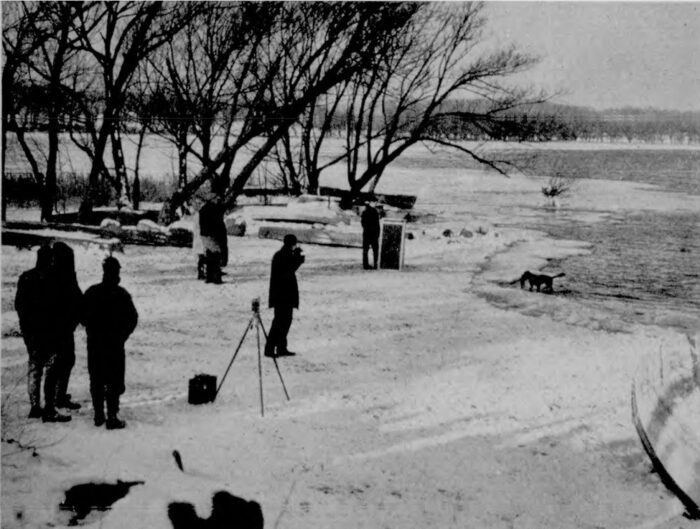
Icy conditions on Lake Mendota. Photo courtesy American Kennel Gazette.
“The weather was bitter and difficult on the great gallery, but it was weather to be expected in the final week of the Wisconsin duck hunting season and no dog who could not meet these conditions could rightfully aspire to the national title.” 2
“To win, Shed had to show supreme ability to bound over frozen hummocks in quest of pheasants and to break sheets of ice in swimming after ducks. In fact, it is hard to imagine more trying conditions than those which the dogs, their handlers and the gallery faced during the three days of the stake. The thermometer was never far from zero, and frequently was below that mark….” 3
Eighteen dogs started, but only five finished, including two owned by Bakewell – Shed and FC Stilrovin Super Speed. The other finishers were FC Hiwood Mike, Patricia of Roedare, and Seaborne’s Black Prince.
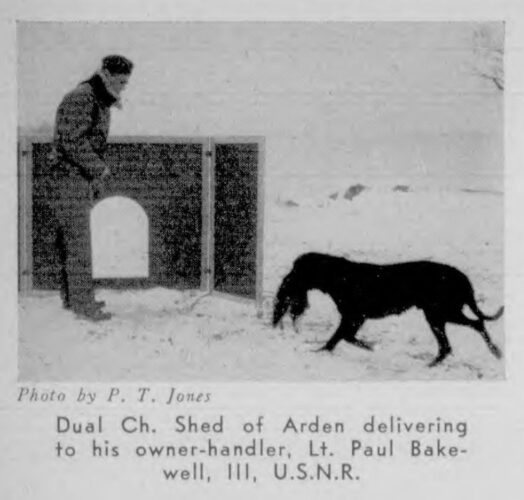
Shed of Arden delivering a bird. Photo courtesy American Kennel Gazette.
“Throughout the meeting Shed did everything asked of him, and did it brilliantly. Probably the thing that most pleased the gallery was the way that willingness was demonstrated when, in the final water test, he never hesitated a minute in crashing his way out through brittle ice…” 4
National Championship 1943
Shed won the National Championship again the next year. He was handled by Clifford H. Wallace because Lt. Bakewell was on active duty.
Bourbon, Missouri hosted the stake on December 3-5, 1943. Twenty dogs started, of those 15 were Labs and five were Goldens. It took two extra series to determine the winner between two dogs – Shed and a Golden Retriever named FC Stilrovin Super Speed. Both dogs were owned by Lt. Bakewell.
Cotton Pershall trained Shed until until it was time to join the Army. At that point, Clifford Wallace took over and guided Shed through the grueling tests in Missouri.
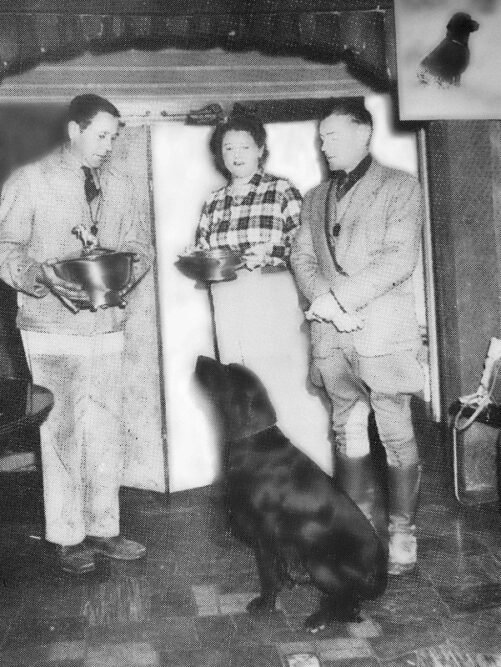
Mrs. Bakewell with Shed and handler C.H. Wallace. Presenting the trophy was M.B. Wallace Jr, trail chairman. Photo courtesy American Kennel Gazette.
Shed didn’t compete in the 1944 National. However, he did travel to Vancouver, British Columbia in October where he finished his Canadian Field Championship.
National Championship 1945
World War II ended in 1945 after Germany surrendered in May and Japan surrendered in September. That November Shed and Bakewell were back to compete in the National Championship. This time it was held at Shelter Island, Long Island, New York, which meant a daily ferry ride from Riverhead. The stake was held on November 30-December 2, 1945.
The first day brought blinding snow and sleet which limited the day to only one series. The second day was cold and windy with high tides and northerly winds. The judges ran land tests in the morning and water tests as the tide ebbed. Despite the conditions, only six dogs were dropped.
Although Shed was a finalist, the judges awarded the win to Black Magic of Audlon.
National Championship 1946
Shed was now seven-years-old, but he continued competing at trials around the country. At a trial in Oregon he had a 300-yard blind retrieve across the tip of a lake for a shackled duck planted several yards off the shore. He was one of only six dogs to complete the series.
In the fall of 1946, Shed reclaimed his crown and is the only three-time winner of the National Championship. It was held on December 6-8. The grounds were good at Crab Orchard Lake, Herrin, Illinois, as was the weather. This is a coal mining area, and the mines were on strike at the time of the National. “… the gallery was augmented by many hundred miners who came to see the event. Some estimated the gallery at 10,000. Traffic presented a bit of a problem.” 5
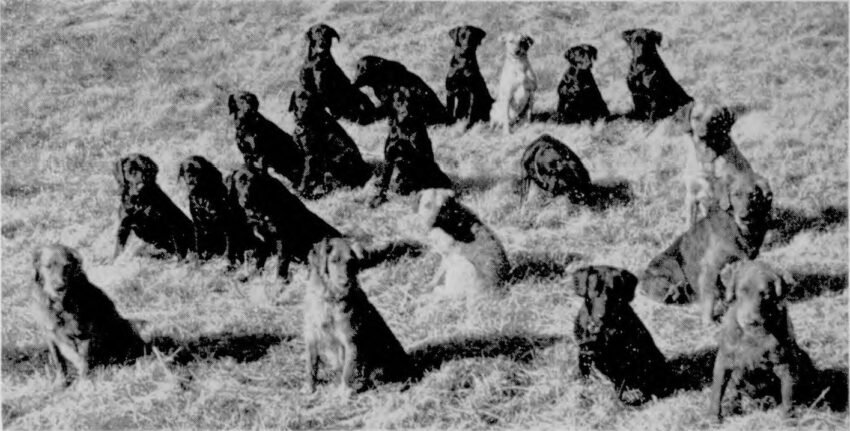
The 20 dogs entered in the 1946 National Championship Stake. Photo courtesy American Kennel Gazette.
Twenty dogs started the stake and eight finished.
In the final series, Shed faced off against three tough competitors. They were his kennel mate, Dual Champion Little Pierre of Deer Creek, plus FC Scoronine of Deer Creek, and a Golden retriever named Stilrovin Nitro Express.
“Scoronine led the field until the last day, then refused to plunge into the 45° water. Now it was Shed’s turn.
“In the toughest test, he had to find two dead ducks which had been planted among the rushes across a 150-foot-wide bay. Shed waited calmly at the water’s edge until he got the signal from Bakewell. Then he plunged bravely into chilly Crab Orchard Lake, but not with his old zip.
“… One-third of the way across, Shed’s black head turned at a whistle from Bakewell to get directions. He entered the cattails just six feet from where the mallard was hidden, sniffed for a second, found his bird. A few minutes later, Shed did it again, and won his third U.S. championship.” 6
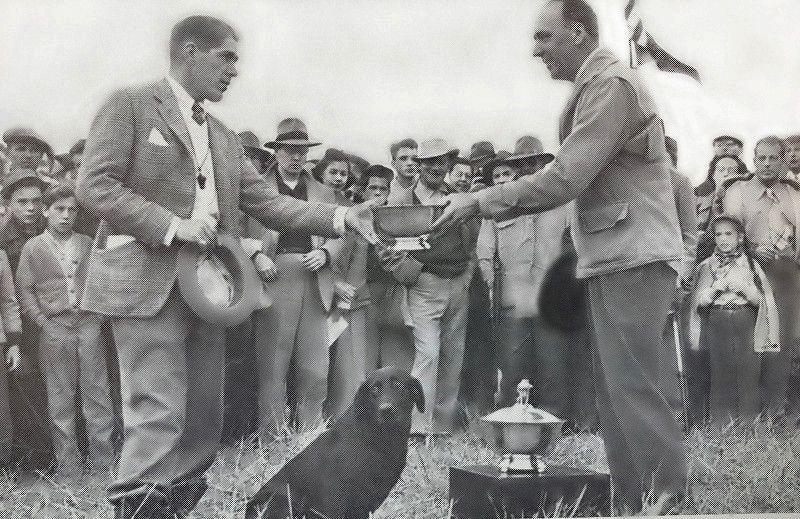
Paul Bakewell received the championship trophy for Shed’s third national championship win.
National Championship 1947
Shed ran the National Championship one more time. The 1947 National was again held at Crab Orchard Lake, Herrin, Illinois. The weather was good with only occasional light rain. Twenty one dogs started, but only four dogs finished. These dogs completed the tenth – and the eleventh – and the twelfth series in an effort to determine the winner. The final series was completed in near darkness.
These dogs were:
FC Black Panther, owned by CW Carlson
FC Black Roland of Koshkonong, owned by Wesley Jung
FC Bracken’s Sweep, owned by DE Pomeroy
DUAL CH & 1942 , 1943, 1946 NATL CH Shed of Arden, owned by Paul Bakewell
Bracken’s Sweep, handled by TW “Cotton” Pershall, was crowned the winner.
Shed’s Family
| CH Raffles of Earlsmoor | Thatch of Whitmore CCW | Eng DUAL CH Titus of Whitmore |
| Tee of Whitmore | ||
| Task of Whitmore CCW | Toi of Whitmore FTW | |
| Eng CH Teazle of Whitmore | ||
| FC Decoy of Arden | Odds On FTW | The Favorite FTW |
| Jest | ||
| Peggy of Shipton FTW | Ronald of Candahar | |
| Gehta of Sigeforda |
His parents
Shed’s sire, Raffles, was Dr. Samuel Milbank’s first Labrador although dogs were always part of his life. His father, Dr. Milbank, Sr., bred Chesapeake Bay Retrievers and terriers.
A Scottish surgeon started the junior Dr. Milbank into Labradors when he found and shipped Raffles to him. According to Helen Warwick in The Complete Labrador Retriever, importing Raffles “started a collaboration of Dr. Milbank and W.A. Harriman that molded the fortunes of the Arden kennel, setting a precedent for quality that has never been equaled by any other Labrador Kennel in America.”
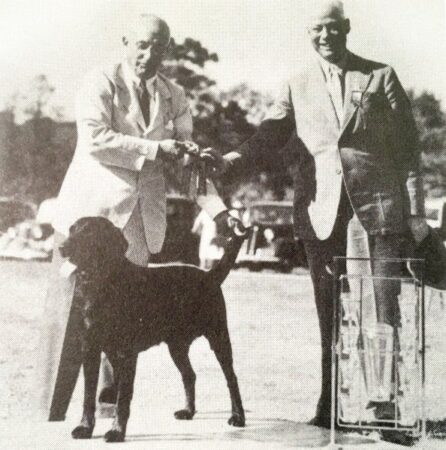
Show champion Raffles of Earlsmoor
Decoy, Shed’s mother, was the second Lab to earn a field trial championship in America. Her full brother, Blind of Arden was the first to earn a field trial championship and also won the first US retriever field stake in 1938.

Field champion Decoy of Arden
Shed descends multiple times from well-known Labs such as English field trial champions Flapper and Peter of Faskally plus the first dual champion Banchory Bolo.
His siblings
Some of Shed’s full siblings included:
- CH Earlsmoor Moor of Arden
- CH Earlsmoor Marlin of Arden
- DUAL CH Gorse of Arden
- DUAL CH Braes of Arden
- CH Bass of Arden
Half siblings included:
- FC Gun of Arden
– Grandsire of 2xNFC Spirit Lake Duke and great-grandsire of DUAL CH CFC Ridgewood Playboy and CH Whygin Gentle Julia Of Avec - Marvadel Cinders
– Dam of Can DUAL CH Coastal Charger of Deer Creek and NFC AFC Marvadel Black Gum
His titled offspring include:
CNFC FC AFC Ardyn’s Ace of Merwalfin
FC AFC Bigstone Bandit
CFC Chanbar Jigaboo ***
CH Chukker of Bonniehurst
NFC AFC Creole Sister
FC Dacity Bill
CH Dauntless of Deer Creek
CH Deer Creek Black Ace
FC Firelei’s Hornet
FC CFC Jibodad Gypsy
CFC Nelson’s Black Prince
FC Pickpocket for Deer Creek
CH Snikeb’s Cookie
CH Trixie’s Black Cargo ***
CH Wardwyn Jackpot
Shed’s descendants at Justamere Ranch:
Chip descends multiple times from Shed. Those bloodlines include:
Dual and field champions –
NFC Dual CH CFC Bracken’s Sweep
Dual CH Grangemead Precocious
CFC Chuck of Bracken
FC Dacity Bill
FC Freehaven Muscles
FC Gilmore’s Peggy
FC Shoremeadow Tidewater
FC AFC Tar Baby of Hilly Hill
Dee also descends multiple times from Shed. Those bloodlines include:
Dual champions –
Dual CH AFC Alpine Cherokee Rocket
Dual CH Cherokee Buck
Dual CH Grangemead Precocious
Dual CH Ridgewood Playboy
Can Dual CH Coastal Charger of Deer Creek
Can Dual CH Dart of Netley Creek
Field champions –
FC AFC Air Express
FC Beautywood’s Carbon Copy
CNFC FC AFC Belle of Zenith
FC AFC Bigstone Bandit
NAFC FC Bracken’s High Flyer
FC AFC Canis Major’s River Bear
NFC AFC CFC Cork of Oakwood Lane
FC AFC Cougar’s Rocket
CFC Crevamoy Iron Duke
2xNAFC FC Dee’s Dandy Dude
FC Deer Creek’s Bewise
2xNFC CNFC AFC Del-Tone Colvin
NAFC FC Dude’s Double or Nothin’
FC Firelei’s Hornet
FC Freehaven Muscles
FC Gilmore’s Peggy
FC AFC Ginger’s Choc August
FC AFC CFC Grady’s Shady Ladee
NAFC FC CFC Guy’s Bitterroot Lucky
AFC Jilly Girl
FC AFC Les Coup De Grace TD
FC Luka of Casey’s Rocket
FC Martens Mister Nifty
FC AFC Mon Tour De Force
FC Mueller’s Stormy Canada
FC Nelgard’s Counter Point
CFC Nelson’s Black Prince
FC AFC Paha-Sapa Chief II
AFC Penny Girl
FC AFC Raider’s Piper Cub
FC AFC Rip’s Bingo
2xNAFC 3x CNFC FC River Oaks Corky
NAFC FC River Oaks Rascal
FC AFC River Oaks Way-Da-Go Rocky
FC Roy’s Rowdy
FC AFC Serrana Sootana of Genesee
FC AFC Shed’s Prince of Garfield
NFC 2xNAFC Super Chief
FC AFC Tar Baby of Holly Hill
2xCNFC AFC Tar Baby’s Little Sweet Stuff
FC AFC CFC Trieven Thunderhead
FC AFC CFC Triple Echo
FC AFC Trumarc’s Raider
AFC Westwinds Shadow of Hope
2x NFC Whygin Cork’s Coot
CNFC FC AFC Yankee Clipper of Reo Raj
FC Zipper Dee Doo
Show champions –
CH Dauntless of Deer Creek
CH Rupert Dahomey
CH Whygin Poppitt
CH Woodcroft Daisy
Conclusion
During his career, Shed earned both US and Canadian Field Championships and a US show championship which qualified him as a DUAL champion. He also ran in five national field championships – winning three times and finishing as a finalist the other two times. At one point his owner turned down an offer to buy him for $10,000 (equivalent of about $150,000 today).
Sometimes the descriptions of field trials from years ago sound more like hunt tests. Don’t be fooled. The tests were real hunting scenarios. On the East Coast, birds were often thrown from a boat well out in the mouth of a bay. An outgoing tide could carry that bird out even farther. Trials were held even if the temperature was below zero, but jumping into frigid water and breaking ice was one of Shed’s specialties. A trial he won as a seven-year-old, included “a 300-yard blind retrieve across the eastern tip of the lake for a shackled duck that was planted several yards from the opposite shore.” 7
He was a good ‘un.
3xNational Field Champion, Canadian Field Champion, Dual Champion Shed of Arden
Whelped: March 26, 1939
Owner: Lt. Paul Bakewell III, Deer Creek Kennel
Breeder: W. Averill Harriman, Arden Kennel
Registration: A-330767
Abbreviations:
CH – Show champion
FC – Field trial champion
NFC – National field trial champion
CCW – English Conformation Certificate winner (not a title)
FTW – English Field trial winner (not a title)
CFC – Canadian field champion
Notes:
[1] The National Retriever Field Trial Club, 1941-1960, 62.
[2] “Victory Well Earned”, New York Times December 12, 1942
[3] “Dual Ch. Shed of Arden Wins Retriever Championship”, American Kennel Gazette, January 1943, 65.
[4] Ibid
[5] The National Retriever Field Club, 1941-1960, 79.
[6] “Sport: An Old Dog’s Day”, Time magazine, December 23, 1946
[7] “Shed of Arden Wins Oregon Open All-Age”, American Kennel Gazette, June 1946, 92.
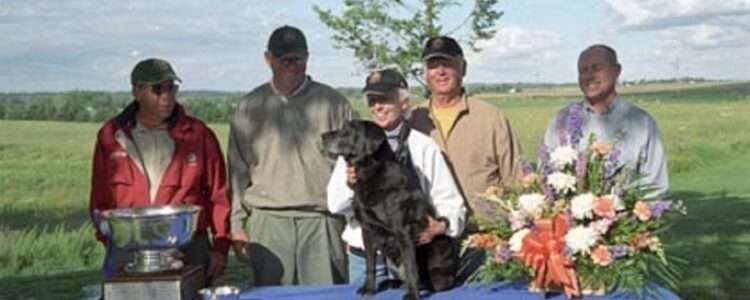
Named for her birthplace in Georgia, Chicka made a name for herself running in field trials.
Chicka’s early years
Her intense retrieving drive was apparent while she was still with her littermates. Her owner said, “She would whirl, twirl and do somersaults” to retrieve anything thrown.
At four months she won a Puppy Stake against dogs more than twice her age. She did it by swimming across a large pond full of sticks and lily pads.
Her career
At a bit over two years old, she won the first of three Double Headers. In all, she qualified six times for the National Open and seven times for the National Amateur. She was a finalist four times.
In 2004, she won the National Amateur with her owner, Lynne, handling.
Lynne described the fifth series, “There were 4 marks, 2 of which were flyers and 2 dead bird-retired marks. The longest of which was about 200 yards. The flyers were visually close to each other and a high number of dogs had to be handled. It was a beautiful series set in a hay bale field with interesting terrain but the hay bales did confuse the dogs. We had all kinds of weather…from hot to cold and rain to sun, plus difficult winds. Additionally, it was a ‘mixed bag’ of birds, which is the most difficult form of retrieval in terms of game. The dogs become keyed into the scent of the first bird retrieved. Then have to re-focus on very different scent for subsequent birds of different species. It really was a make or break series.”
Injuries
What makes Chicka’s career even more impressive is the injuries she overcame. In one surgery, she had two ruptured lumbar spinal discs removed. Another surgery was a total replacement of her right hip. She spent more time in rehab than in training in the 2-1/2 years before her National win.
Chicka was also featured in a magazine for disabled sports men and women.
Pedigree
| 2xNAFC 2xCNAFC FC CFC Ebonstar Lean Mac | CNFC CNAFC Waldorf’s High Tech | CFC Rascal’s Super Spud |
| Itch’s Flying Tiger | ||
| Ebonaceae Princess WCX QAA | Trieven El Conquistador | |
| Skookum’s Sky Raider | ||
| Lazer’s Razor Sharp MH | FC AFC Donnybrooks Rocky Road | FC AFC Connies Little Thunder |
| Raintree Farms Mint Julep | ||
| Snakes Midnight Lazer MH | Spider Man II | |
| Snake’s Whistling Wind |
Famous relatives
Chicka was sired by Ebonstar Lean Mac and out out of Lazer’s Razor Sharp MH. She also descends from NFC 2xNAFC Super Chief (Hall Of Fame) and his relatives:
- FC AFC Air Express HOF
- FC AFC Ithin’ To Go
- FC AFC CFC Trieven Thunderhead HOF
- CNFC FC Wanapum Darts Garbo
- Super Powder QAA
There are many other great Labs in her pedigree, including National Field Champions and National Amateur Field Champions. Some have also been inducted into the Hall of Fame.
Plus there are show champions, English imports and dual champions, including 3xNFC CFC Dual Ch Shed of Arden HOF.
Although she may be the best known dog in her litter, there are other titled dogs. Her brother, Law Abiding Ezra, earned his FC and AFC plus an Obedience Trial Championship (OTCH). Ezra also sired a daughter who earned her OTCH plus UDX2 and MH.
Other siblings have field championship and/or hunt test titles. Then you could spend hours looking through the list of half-siblings sired by her father.
NAFC FC Chickamauga Choo Choo
Whelped: May 21, 1996
Died: Dec 5, 2008
Owners: Lynne and Mac DuBose, Hillsborough, NC
Breeders: Vincent and Phyllis Garner
Registration: SN36231305
Accomplishments:
34 Derby points
QAA before 2 years old
3x Double Header winner
64.5 Open points
120 Amateur points
National Amateur Field Champion
2012 Retriever Hall of Fame
Glossary:
CH – Show Championship
FC – Field Championship
AFC – Amateur Field Championship
NFC – National Field Champion
NAFC – National Amateur Field Champion
CFC – Canadian Field Championship
CAFC – Canadian Amateur Field Championship
CNFC – Canadian National Field Champion
Double-header – to win both the Open and Amateur stakes at the same field trial
QAA – Qualified All-Age
MH – Master Hunter
OTCH – Obedience Trial Championship
UDX – Utility Dog Excellent obedience title
HOF – Hall of Fame

Banchory Bolo was the first-ever Dual Champion Labrador Retriever.
His is an interesting story. Not just rags to riches, but riches to rags and back to riches. Pull up a chair and learn about the dog who still has an influence on Labradors over one hundred years after his birth.
Bolo’s early years
Bolo was two years old when Mrs. Quintin Dick (later Lorna, Countess Howe) entered his life. She had owned his sire, Scandal of Glynn, who was “a charming and beloved companion and a great game-finder.”
When Scandal died, she wanted to find a dog to replace him. Unfortunately, none of the other dogs she owned could fill the gap his passing caused.
Her husband, Quintin Dick, suggested a son by Scandal. However, during the First World War breeding was restricted and Scandal had only sired one litter. In it, there were 13 puppies of which 12 were females.
The only male – originally named Caerhowell Bully – had been given away by his breeder. When Lorna(1) found him, he was given to her with the advice that if she didn’t want to keep him to have him put to sleep. They told her the dog was “hopeless” and had “an evil temper.”
When she picked him up at the train station, she realized what she’d been told was true. The dog was unkempt, had sores on his ears and he growled at her through the heavy muzzle he wore. Although he had a wonderful pedigree, she debated: Should she keep him or put him to sleep as she’d been advised?
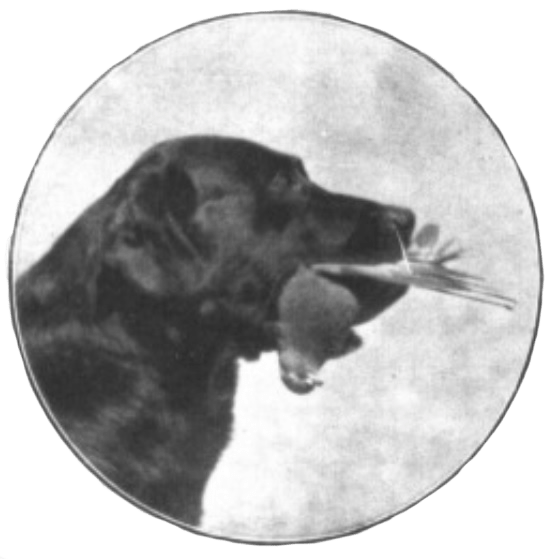
Banchory Bolo
Lorna and Bolo
She must have had a kind heart as she took him home with her. After taking off the muzzle and chain, she turned him loose in a spacious room, but he was distrustful and surly. He wouldn’t come to anyone and it took quite a while to catch him.
Something must have happened to him in his earlier life. Heavy-handed trainer? Malicious kennel help?
He avoided people. When turned out for exercise, he was hard to catch. How could he be trained when he was so distrustful of people? What could soothe the savage beast?
It turns out it wasn’t music, but Lorna’s gentle care. When he became seriously ill, she nursed him back to health. During that time, he realized she was someone he could trust. As he recovered he became devoted to her and was always at her side.
The stirrings of greatness
When he started in training, Lorna found he had “a natural love of retrieving, an excellent nose, and a perfect mouth.” However, he also had two failings: he loved chasing rabbits and was terrified of cracking whips. One day when a stable boy happened to crack a whip near him, the fear took over and Bolo blindly sought escape. A tall, spiked gate didn’t stop him from running.
He returned early the next morning, covered in blood. “He had two very deep wounds on his chest, a tear three inches long in his groin and his hind leg and hock torn so badly that the bone was visible.” Because a veterinarian was too far away, Lorna stitched his wounds as he lay still for her.
Her doctoring and subsequent training was well done as the next fall he won a field trial prize. Then he quickly won two field trials and became a field champion. Two years later he also finished his show championship and became the first Dual Champion Labrador.
Lorna said, “He had quite the best nose I have ever seen in a dog and with apparently the greatest ease he would collect runner after runner after several other dogs had failed. I have never had a dog with such great natural ability or one so anxious to please me in every possible way.”
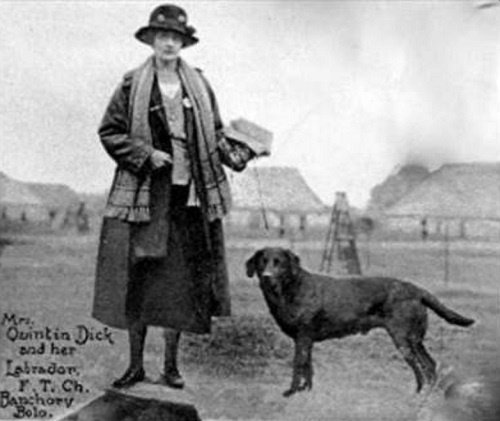
Lorna, Countess Howe and Banchory Bolo
From greatness comes greatness
The genes from several great dogs came together in Banchory Bolo. We have Lord Malmesbury, the Dukes of Buccleuch, and Lord Knutsford (Munden kennels) to thank for their breeding insight and the dogs they produced.
Banchory Bolo’s pedigree:
| Scandal of Glynn | English FTCh Peter of Faskally | Waterdale Gamester |
| Birkhill Juliet | ||
| English FTW Shelagh of Glynn | English FTW Scamp of Glynn | |
| Shelagh of Danesbury | ||
| Caerhowell Nettle | Foxley Kennett | Hirsch’s Ranger |
| Bendysh Bess | ||
| Baker’s Nora | unknown | |
| unknown |
His family
Looking backward in time, Bolo’s sire, Scandal of Glynn, was a son of English FTCh Peter of Faskally. Peter won the International Gundog League’s Championship Stake for retrievers in 1911, but it was his partnership with his handler, Archie Butter, that set him apart from the other retrievers.
Butter realized that if a dog could be guided by his handler, the quicker he would be able to find and retrieve game. To do this, he adapted the methods used by shepherds when handling their dogs using whistles and hand signals. We still use a form of this method today.
Peter of Faskally’s pedigree is filled with dogs from the Munden and Buccleuch kennels. Munden Sixty (born 1897) appears three times in Peter’s pedigree and once more in Scandal of Glynn’s maternal line.
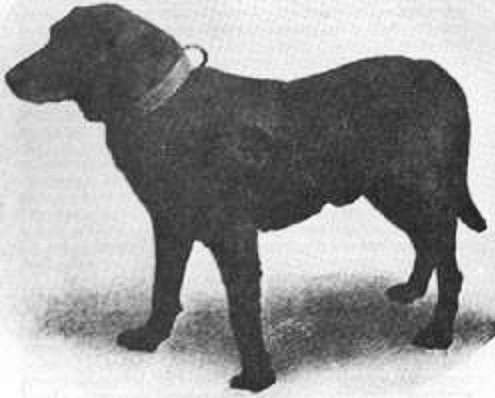
Buccleuch Avon
Sixty’s paternal grandfather, Buccleuch Avon (born 1885), was a gift from the third Earl of Malmesbury to the sixth Duke of Buccleuch.
Avon was sired by Malmesbury Tramp (born 1878) and out of Malmesbury Juno (born 1878). Another male, Buccleuch Ned (born 1882), was also a gift. These dogs were bred to bitches that descended from dogs imported originally by the fifth Duke of Buccleuch.
Another great in Peter of Faskally’s pedigree is Munden Single (born 1899). She was sired by Munden Sixty and descended from Munden, Buccleuch, and Malmesbury dogs. She’s best known for being the first Labrador to win a Challenge Certificate and the first Labrador to run in a field trial.
More Munden, Buccleuch, and Malmesbury
Less is known about Scandal of Glynn’s maternal side. His maternal grandfather, Scamp of Glynn FTW, traces to Buccleuch Ned, the other male gifted by Lord Malmesbury. And his maternal grandmother, Shelagh of Danesbury, is mostly from Munden dogs that trace back to the Buccleuch and Malmesbury kennels.
Even less is known about Banchory Bolo’s mother, Caerhowell Nettle, although her father traces back to Peter of Faskally as well.
Bolo’s legacy
With all the good genes passed down from his ancestors, it’s not surprising that he also produced well. He sired both show champions and field trial champions.
Bolo’s show offspring
In 1921, he was bred to Brocklehirst Nell (owned by Mrs. Dinwoodie) and sired English Ch Banchory Bluff, English FTCh Nith of Halleaths, and Brocklehirst Daisy FTW. Bluff was the maternal grandsire of English FTCh Balmuto Hewildo. Bluff was owned by Lorna.
Also in 1921, he was bred to Murrayfield Bett (owned by Mr. Dinwoodie) and sired English Ch Brocklehirst Donner. This dog was also owned by Lorna.
Yet another litter in 1921, produced English Ch Beningbrough Tangle. He finished his show championship, including winning the CC at Crufts in 1930 and he also won a field trial. So close to being another Dual Champion! He was bred by The Earl of Chesterfield and owned by Lorna. His mother was Thyme, a daughter of English Ch Ilderton Ben.
In 1922, Bolo was bred to a granddaughter of English Ch Ilderton Ben. Her name was Malta of Lunn and was owned by the Earl of Clarendon. In this litter was a female named English Ch Banchory Kelpie, owned by Lorna.
Breeding dogs all but stopped during World War I. This sent the Munden kennel to the edge of extinction. However Lorna “gave Lord Knutsford a puppy on the condition that he should eventually breed her with Dual Champion Banchory Bolo.”
He registered this puppy as Munden Scarcity. Her sire was English Ch Banchory Lucky and her dam was Banchory Betty. In Scarcity’s litter by Bolo, she produced both English Ch Banchory Danilo FTW and English Ch Munden Solo FTW. Lord Knutsford also kept Singer, a bitch, and another bitch was given to His Majesty the King.
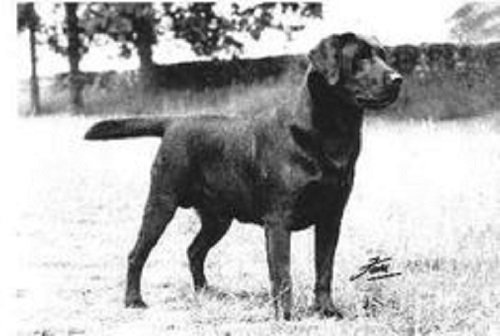
Banchory Danilo
One of Bolo’s best sons
Danilo won 33 Challenge Certificates in the show ring and won the best exhibit in the Kennel Club Show in 1925. He went on to also win two field trial honors in 1924, handled by Lorna. Danilo sired English Ch Drinkstone Pons of Wingan (sire of American Ch Echo of Arden), English Ch Drinkstone Dan, and Haylers Danilo (sire of English Ch Poppleton Black Lancer).
When Danilo’s grandson, Hiwood Risk, was bred to Peggy of Shipton we see some of the Arden dogs, including American National Field Champion Tar of Arden and her offspring – American FC Firelei of Deer Creek, American NFC Black Magic of Audlon, American Dual Ch CFC Little Pierre of Deer Creek.
Danilo’s brother, Munden Solo, also did well at shows. At Crufts in 1927, he competed in ten classes, won six, and placed in three more. The judge wrote of him, ‘If there had been a little more of him in size, I think he would have been very near perfection.’
Bolo sired another English show champion, Banchory Bolo’s Trust, in 1926. His mother was Beaulieu Nance (daughter of English DUAL Ch Banchory Sunspeck).
English DUAL Ch Bramshaw Bob, double-bred on Bolo, won Best in Show at Crufts twice – 1932 and 1933. Lorna bought him from Sir George Thursby and when she took him to Crufts in 1932, Bob won all the classes he was entered in and won Best in Show on the second day.
Lorna said, “Cruft’s Show was, and still is, a great meeting place for gamekeepers. I shall never forget the overwhelming reception they gave Bob when the award was announced; it was so kind of them. They were pleased that a working gundog should receive this much-coveted award.”
Bolo’s field offspring
Bolo was bred to Kirkmahoe Dinah FTW in 1921. This litter included English National FTCh Kirkmahoe Rover, Banchory Corbie FTW, and Choice Of Kirkmahoe FTW.
Banchory Corbie won one Challenge Certificate (show points) and won the 1923 International Gundog League (IGL) Nomination Stake. Then he “broke his shoulder by galloping into a guard post” thus ending his show and field trial career. Lorna described him, “Corbie was in character and temperament all that a Labrador should be. He was highly intelligent, very faithful, a wonderful watch-dog and guard, yet very gentle with children. He had the great game-finding ability which goes with good nose and the brains to use it.”
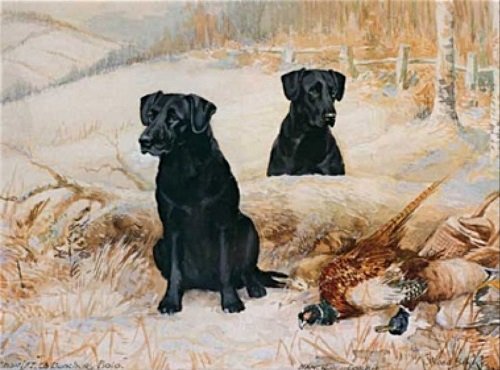
Banchory Bolo and his son, Banchory Corbie
Another Bolo son was born in 1923, Banchory Roger FTW. He was linebred on English National Ch Peter of Faskally and on Munden Sentry.
Another male, English FTCh Balmuto Hewildo, was also double-bred on Bolo. Instead of winning in the show ring, he won the IGL Retriever Championship in 1936. This is comparable to the National Retriever Championship in the US.
In short, Bolo was a great producer.
A legend
Author C. Mackay Sanderson wrote, “Bolo’s coming may be said to have breathed a spirit of new life into the breed, the prestige enjoyed by this dog as a competitive and stud force giving lasting impetus to Labrador fortunes and subsequently his name runs like a golden thread through all the vital streams of progress.”
“The Field wrote of Bolo: ‘If ever evidence were needed of the character of a great dog, and of his influence on the generations following him, it was to be found at the Retriever Championship Trial held at Idsworth last week [December 1932]. Out of fourteen dogs that won prizes, eight were descended from Banchory Bolo.'”
But Bolo also had another legacy – he tended to throw white hairs on the feet. These ‘Bolo marks’ or ‘Bolo pads’ are still sometimes seen on the bottom of the front feet and/or the back of the front pasterns.
Bolo died in July 1927. It was ten years before Lorna was able to give her heart to another dog.
English Dual Champion Banchory Bolo
Whelped: December 29, 1915
Died: July 10, 1927
Owner: Lorna, Countess Howe (AKA Mrs. Quintin Dick)
Breeder: Sir John S Harmood-Banner
Original name: Caerhowell Bully
Registration: KC SB 218AA
1. Although she became Lorna, Countess Howe because of her second marriage, she was known as Mrs Quintin Dick during Bolo’s lifetime. However for the sake of ease, I’ve used her first name here as it’s how she’s known by Lab enthusiasts worldwide.
Abbreviations:
Ch – Show champion
CC – Challenge Certificate (show points)
FCh – Field trial champion
NFCh – National field trial champion
FTW – Field trial winner (not a title)
CFC – Canadian field champion
IGL – International Gundog League
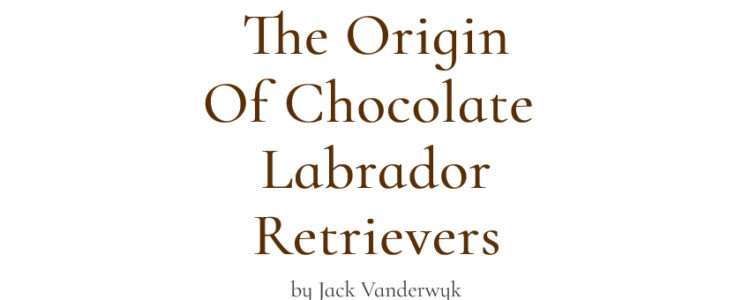
Studying the pedigrees of chocolate Labrador Retrievers, you often wonder where the chocs are coming from. All of a sudden they are there, out of the blue. I studied the files in the LabradorNet database, which contains the pedigrees of more than 90,000 Labradors, and came to the conclusion that there are roughly 8 routes to the origin of chocolate Labs.
One of the reasons that you’ll find no chocolate Labs in the older files, is that they weren’t in fashion for many decades, so they just weren’t registered. However, the blacks and the yellows carrying the choc gene kept reproducing, and that’s why we’re able to trace them all the way back to the late 1800s.
Note: This article was written by Jack Vanderwyk. After his death his domain name was usurped by someone else. Fortunately I had a copy of his work and it’s shared here in a tribute to the research he did on Labrador Retriever pedigrees.
ORIGINS OF THE CHOCOLATE GENE
According to the studbook of Buccleuch Kennels, the chocolates in that kennel came through FTW Peter of Faskally (1908). However, Peter of Faskally was a descendant of Buccleuch Avon (1885).
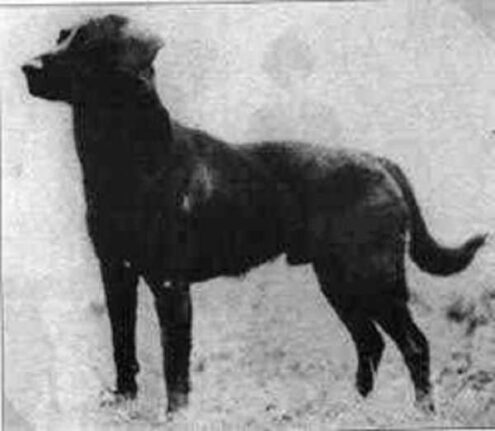
Peter of Faskally

Buccleuch Avon
The Earl of Feversham had some typical specimen of chocolates, his Nawton Pruna (who produced yellow offspring) did well at field trials in the years preceding the First World War.
One of the chief supporters of chocolates was the Hon. Lady Ward of Chiltonfoliat, near Hungerford, the dogs from her kennel being very typical with particularly good tails and coats. Her chocolate bitch FTW Darry of Chiltonfoliat (Braeroy Darkie) (1930) was sired by an unregistered chocolate dog called Jimmy, while her dam descended from the chocolate Flatcoat Clyde (see further down).
Mr. J.G. Severn of Tibshelf Kennels wrote: “My first experience of the chocolate Labradors was in February, 1938, when I visited Dr. Montgomery of Sutton Ashfield, about three miles from Tibshelf. We had mated his black bitch Shelagh of Brasidonia to my black dog Danilo of Tibshelf. Result: 4 blacks, 2 chocolate dogs, 1 cream bitch. I later bought Shelagh and mated her again to Danilo. Result just the same.”
Miss Wills of Metesford Kennels produced several chocolates in the late 1940s, early 1950s, but their descendance is not known.
CROSSES IN THE EARLY BREED
Further more we should keep in mind that there are a lot of missing links in our database, and sometimes the reasons for this are rather obvious. I found 21 interbred or fullbred Flatcoats or Chesapeake Bay retrievers in our Labrador retriever database, all born in the U.K. between 1914 and 1933.
Of all the 21 interbred or fullbred Flatcoats or Chesapeake Bay retrievers, most of them being Field Trial champions, we could only track the ancestors for more than two generations of two dogs. The information about the ancestors of the other 19 interbred dogs was simply removed from the files in the 1930s. It seems that some well known Labrador breeders didn’t want the public to know that their successful dogs were partly the offspring of interbred dogs.
Two well known Chesapeake Bay retrievers were a dog called Jolly, who sired the male Labrador retriever Jolly Sam, born before 1933, and the bitch Corydalys, who was the dam of the female Labrador retriever Micklefield Juno, born before 1925.
Clyde, born before 1923, was the “liver” (chocolate) Flatcoat retriever who sired the male yellow Labrador FTW Folkingham Bexter (1925), who in turn sired the yellow bitch FTW Limekiln Rhoda (1927). She and the yellow dog FTW Golden Morn (1926) had a litter that was registered as “half Golden Retriever and half Labradors”. The separation was by coat length, because all puppies were yellow. Apparently the third generation showed some traits of the original breed involved.
The chocolate Labrador may not have been very popular prior to the 1960s, but they were mentioned as early as 1927, in The Book of Dogs, published by the National Geographic Society in 1927: “This Labrador dog, crossed probably with the English setter, and perhaps with other breeds, produced the Retriever, which may be either black or liver-brown.” (The yellow Labrador was organized in The Yellow Labrador Retriever Club, in 1924.)
ROUTES TO THE EARLY CHOCOLATE GENE
Route 1 (version 1):
– Morningtown Tobla (f, choc, < 1976)
- Brentville Ebony (f, black, <1974)
- Knavery Mistress Meg (f, black < 1972)
- Sandylands Mark (m, black, 1965)
– Reanacre Mallardhurn Thunder (m, black, 1960)
– Mallardhurn Pat (f, yellow, < 1958)
- Poppleton Lieutenant (m, yellow, 1949)
- Poppleton Golden Sunray (f, yellow, < 1947)
- Poppleton Golden Major (m, yellow, < 1940)
- Poppleton Black Lancer (m, black, 1934)
- Haylers Danilo (m, black < 1932)
- Banchory Danilo (m, black, 1923)
- Banchory Bolo (m, black, 1915)
– Scandal of Glynn (m, black, < 1913)
- Shelag of Glynn (f, black, < 1911)
- Shelag (f, colour unknown, < 1909)
- Munden Sentry (m, black, 1900)
- Munden Sixty (m, black, 1897)
- Buccleuch Nith (m, black, 1891)
- Buccleuch Avon (m, black, 1885)
- Malmesbury Tramp (m, black, 1878).[/st_text][/st_column][st_column span="span6"][st_image image_file="https://justamere.com/wp-content/uploads/2023/04/Sandylands-Mark.jpg" image_size_wrapper="" image_size="full" image_alt="Sandylands Mark, a famous show champion Labrador Retriever and stud dog" image_alignment="center" id_wrapper="image_fdd536cac8f3d3e21e9f3c9a780623b9" ][/st_image][st_text el_title="Sandylands Mark" text_margin_top="10" id_wrapper="text_ee2bb854c3a5e4ec7be402f33a30736e" ]
Sandylands Mark
Route 1 (version 2):
– Morningtown Tobla (f, choc, < 1976)
- Brentville Ebony (f, black, <1974)
- Knavery Mistress Meg (f, black < 1972)
- Sandylands Mark (m, black, 1965)
- Reanacre Mallardhurn Thunder (m, black, 1960)
– Mallardhurn Pat (f, yellow, < 1958)
- Poppleton Lieutenant (m, yellow, 1949)
- Poppleton Golden Sunray (f, yellow, < 1947)
- Poppleton Golden Major (m, yellow, < 1940)
- Poppleton Black Lancer (m, black, 1934)
- Haylers Danilo (m, black < 1932)
- Boris de Main (f, yellow, < 1930), child of:
Sceptre (m, colour unknown, not registered, < 1928) and
Countess (f, colour unknown, not registered, < 1928).
However, Buccleuch Avon, born in 1885, so almost 40 years before, is known to have produced some chocolate offspring, so it's more likely that either his sire Malmesbury Tramp, or his dam Malmesbury June (f, black, 1880), or both, already carried the chocolate gene.[/st_text][/st_column][st_column span="span6"][st_image image_file="https://justamere.com/wp-content/uploads/2022/03/Reanacre-Mallardhurn-Thunder-1960-e1682638638659.jpg" image_size_wrapper="" image_size="full" image_alt="Reanacre Mallardhurn Thunder, an English show champion Labrador Retriever from the 1960s" image_alignment="center" id_wrapper="image_c289d382003fbdbc6f4a52a23d679d7c" ][/st_image][st_text el_title="Reanacre Mallardhurn Thunder" text_margin_top="10" id_wrapper="text_d1c8ad849fe459926c5cf15ae198bb35" ]
Reanacre Mallardhurn Thunder
Route 2:
– Follytower Merrybrook Black Stormer (m, black, 1969)
– Sandylands Tandy (m, yellow, 1961)
– Sandylands Shadow (f, black, 1959)
– Diant Pride (f, yellow, < 1957)
- Poppleton Lieutenant (m, yellow, 1949)
- Poppleton Golden Sunray (f, yellow, < 1947)
- Poppleton Golden Major (m, yellow, < 1940)
- Poppleton Black Lancer (m, black, 1934)
- Haylers Danilo (m, black < 1932)
- Banchory Danilo (m, black, 1923)
- Banchory Bolo (m, black, 1915)
- Scandal of Glynn (m, black, < 1913)
- Shelag of Glynn (f, black, < 1911)
- Shelag (f, colour unknown, < 1909)
- Munden Sentry (m, black, 1900)
- Munden Sixty (m, black, 1897)
- Buccleuch Nith (m, black, 1891)
- Buccleuch Avon (m, black, 1885)
- Malmesbury Tramp (m, black, 1878).[/st_text][/st_column][st_column span="span6"][st_image image_file="https://justamere.com/wp-content/uploads/2022/03/Follytower-Merrybrook-Black-Stormer-1969-e1682639040835.jpg" image_size_wrapper="" image_size="full" image_alt="Follytower Merrybrook Black Stormer, a show Labrador and prepotent stud dog" image_alignment="center" id_wrapper="image_561b6197c9676a065fb8d4803dfb49ab" ][/st_image][st_text el_title="Follytower Merrybrook Black Stormer" text_margin_top="10" id_wrapper="text_2034d43c2c3092e178d84394236fd34a" ]
Follytower Merrybrook Black Stormer
Route 3:
– Fabracken Comedy Star (m, black, 1979)
– Martin of Mardas (m, black, 1975)
– Ballyduff Marketeer (m, black, 1974)
– Sandylands Mark (m, black, 1965)
– Reanacre Mallardhurn Thunder (m, black, 1960)
– Mallardhurn Pat (f, yellow, < 1958)
- Poppleton Lieutenant (m, yellow, 1949)
- Poppleton Golden Sunray (f, yellow, < 1947)
- Poppleton Golden Major (m, yellow, < 1940)
- Poppleton Black Lancer (m, black, 1934)
- Haylers Danilo (m, black < 1932)
- Banchory Danilo (m, black, 1923)
- Banchory Bolo (m, black, 1915)
- Scandal of Glynn (m, black, < 1913)
- Shelag of Glynn (f, black, < 1911)
- Shelag (f, colour unknown, < 1909)
- Munden Sentry (m, black, 1900)
- Munden Sixty (m, black, 1897)
- Buccleuch Nith (m, black, 1891)
- Buccleuch Avon (m, black, 1885)
- Malmesbury Tramp (m, black, 1878).[/st_text][/st_column][st_column span="span6"][st_image image_file="https://justamere.com/wp-content/uploads/2022/03/Fabracken-Comedy-Star-e1682639413905.jpg" image_size_wrapper="" image_size="full" image_alt="Handsome black Lab named Fabracken Comedy Star, standing near a river" image_alignment="center" id_wrapper="image_38c75d728a04949b17ced37f170e64e5" ][/st_image][st_text el_title="Fabracken Comedy Star" text_margin_top="10" id_wrapper="text_84291af2c46e69adce952479c459fe52" ]
Fabracken Comedy Star
Route 4:
– Olivia of Blaircourt (f, black, < 1954) - Lawrie of Blaircourt (m, black, < 1952) - Fiona of Blaircourt (f, black, < 1950) - Treesholme Thunder (m, black, < 1948) - Triumph of Treesholme (m, yellow, < 1946) - Poppleton Golden Sherry (f, yellow, < 1944) - Poppleton Golden Gleam (f, yellow, < 1942) - Poppleton Golden Major (m, yellow, < 1940) - Poppleton Black Lancer (m, black, 1934) - Haylers Danilo (m, black < 1932) - Banchory Danilo (m, black, 1923) - Banchory Bolo (m, black, 1915) - Scandal of Glynn (m, black, < 1913) - Shelag of Glynn (f, black, < 1911) - Shelag (f, colour unknown, < 1909) - Munden Sentry (m, black, 1900) - Munden Sixty (m, black, 1897) - Buccleuch Nith (m, black, 1891) - Buccleuch Avon (m, black, 1885) - Malmesbury Tramp (m, black, 1878).[/st_text][/st_column][st_column span="span6"][st_image el_title="Martin of Mardas" image_file="https://justamere.com/wp-content/uploads/2022/03/Martin-of-Mardas.jpg" image_size_wrapper="" image_size="full" image_alt="Martin of Mardas, a black Labrador Retriever show dog" image_alignment="center" id_wrapper="image_e734f3b0a0096ca2dfc744a3f6f7239d" ][/st_image][st_text el_title="Martin of Mardas" text_margin_top="10" id_wrapper="text_8e5de3eab75d9ef9a6612bcb60cd3b36" ]
Martin of Mardas
Route 5:
– Pride of Craigavon (m, chocolate, < 1974)
- Taffy of Keithray (m, black, 1965)
- Sandylands Tweed of Blaircourt (m, black, 1958)
– Ruler of Blaircourt (m, black, 1956)
– Olivia of Blaircourt (f, black, < 1954)
- Lawrie of Blaircourt (m, black, < 1952)
- Fiona of Blaircourt (f, black, < 1950)
- Treesholme Thunder (m, black, < 1948)
- Triumph of Treesholme (m, yellow, < 1946)
- Poppleton Golden Sherry (f, yellow, < 1944)
- Poppleton Golden Gleam (f, yellow, < 1942)
- Poppleton Golden Major (m, yellow, < 1940)
- Poppleton Black Lancer (m, black, 1934)
- Haylers Danilo (m, black < 1932)
- Banchory Danilo (m, black, 1923)
- Banchory Bolo (m, black, 1915)
- Scandal of Glynn (m, black, < 1913)
- Shelag of Glynn (f, black, < 1911)
- Shelag (f, colour unknown, < 1909)
- Munden Sentry (m, black, 1900)
- Munden Sixty (m, black, 1897)
- Buccleuch Nith (m, black, 1891)
- Buccleuch Avon (m, black, 1885)
- Malmesbury Tramp (m, black, 1878).[/st_text][/st_column][st_column span="span6"][st_image el_title="Sandylands Tweed of Blaircourt" image_file="https://justamere.com/wp-content/uploads/2022/03/Sandylands-Tweed-of-Blaircourt_1958-e1682640236289.jpg" image_size_wrapper="" image_size="full" image_alt="Sandylands Tweed of Blaircourt, a famous show and stud dog" image_alignment="center" id_wrapper="image_27143f1855b06221b27c5477b20d4dfa" ][/st_image][st_text el_title="Sandylands Tweed of Blaircourt" text_margin_top="10" id_wrapper="text_7acb8cc03d8e84e302c769847201f742" ]
Sandylands Tweed of Blaircourt
Route 6:
– Cookridge Oscar (m, chocolate, < 1960)
- Bickerton Salmon Prince (m, yellow, < 1958)
- Blondie of Gloamin (f, yellow, < 1956)
- Raider of Gloamin (m, colour unknown, < 1954)
- Marquis of Gloamin (m, yellow, < 1944)
- Poppleton Golden Major (m, yellow, < 1940)
- Poppleton Black Lancer (m, black, 1934)
- Haylers Danilo (m, black < 1932)
- Banchory Danilo (m, black, 1923)
- Banchory Bolo (m, black, 1915)
- Scandal of Glynn (m, black, < 1913)
- Shelag of Glynn (f, black, < 1911)
- Shelag (f, colour unknown, < 1909)
- Munden Sentry (m, black, 1900)
– Munden Sixty (m, black, 1897)
– Buccleuch Nith (m, black, 1891)
– Buccleuch Avon (m, black, 1885)
– Malmesbury Tramp (m, black, 1878).
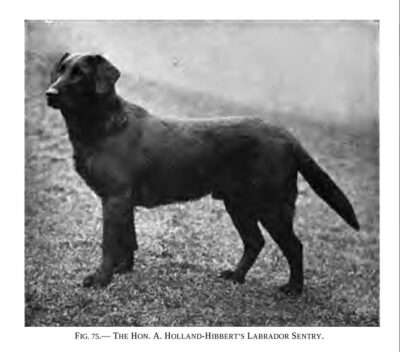
Munden Sentry
Route 7:
– Chocolate Lady (f, chocolate, < 1954) - Harehope Bliss (m, black, 1936) - Weston Bunty (f, black, < 1934) - Adderley Tyke (m, black, 1929) - Adderley Trim (f, black, 1927) - Beningbrough Tanco (m, black, 1924) - Banchory Corbie (m, black, 1921) - Banchory Bolo (m, black, 1915) - Scandal of Glynn (m, black, < 1913) - Shelag of Glynn (f, black, < 1911) - Shelag (f, colour unknown, < 1909) - Munden Sentry (m, black, 1900) - Munden Sixty (m, black, 1897) - Buccleuch Nith (m, black, 1891) - Buccleuch Avon (m, black, 1885) - Malmesbury Tramp (m, black, 1878).[/st_text][/st_column][st_column span="span6"][/st_column][/st_row][st_row ][st_column span="span6"][st_text el_title="route 8" id_wrapper="text_4b035793d80c131265930cb8ade3a015" ]
Route 8:
– Hiwood Mike (m, black, 1935), via Pettistree Dan (m, black, 1934)
– Quest of Wilbury (f, black, 1930)
– Muntham Raven (f, black, 1924)
– Banchory Corbie (m, black, 1921)
– Banchory Bolo (m, black, 1915)
– Scandal of Glynn (m, black, < 1913)
- Shelag of Glynn (f, black, < 1911)
- Shelag (f, colour unknown, < 1909)
- Munden Sentry (m, black, 1900)
- Munden Sixty (m, black, 1897)
- Buccleuch Nith (m, black, 1891)
- Buccleuch Avon (m, black, 1885)
- Malmesbury Tramp (m, black, 1878),
AND
via Pettistree Poppet (f, colour unknown, < 1933)
- Cransford Flapper (f, colour unknown, < 1931)
- Peter of Bircham (m, colour unknown, < 1930)
- Banchory Danilo (m, black, 1923)
- Banchory Bolo (m, black, 1915)
- Scandal of Glynn (m, black, < 1913)
- Shelag of Glynn (f, black, < 1911)
- Shelag (f, colour unknown, < 1909)
- Munden Sentry (m, black, 1900)
- Munden Sixty (m, black, 1897)
- Buccleuch Nith (m, black, 1891)
- Buccleuch Avon (m, black, 1885)
- Malmesbury Tramp (m, black, 1878).[/st_text][/st_column][st_column span="span6"][/st_column][/st_row][st_row id_wrapper="elm_644b0daa73335" ][st_column span="span12"][st_text el_title="more research" id_wrapper="text_be01bbdf89f946df3eba025f8762c099" ]
MORE RESEARCH
I researched some 30 well known chocolate Labrador Retrievers without any known chocolate ancestors, and their pedigrees all fit in with one (or several) of the routes above. Please keep in mind that famous Labradors like Boothgates Headliner, Lindall Mollie Malone, Morningtown Stormette etc all descend from Morningtown Tobla (route 1).
Aroscas Chocolate Surprise: route 1, via Sandylands Mark.
Bradking Cassandra: route 2, directly and via Ardmargha Mad Hatter and Sandylands Mark.
Brendale Brown Betty: route 2 and 5.
Brentwoods Sweet Molly Brown: route 2, via Mardas Brandlesholme Sam’s Song.
Captain Kirk of Rangeways: route 1 and 2.
Castlemore Bramble: route 1 via Sandylands Mark, route 5 via Pride of Craigavon.
Charway Mattie Brown: route 3.
Charway Sally Brown: route 2.
Chocolate Lady: route 7, via Harehope Bliss.
Cookridge Oscar: route 6, via Bickerton Salmon Price.
Cookridge Tango: route 5, via Sandylands Tweed of Blaircourt.
Could Be’s Chestnut Wrangler: route 4, via Could Be’s Rusty Rock, Could Be’s Haven Rock, Indian Valley Rob Roy, Bart of Blaircourt and Rush of Blaircourt.
Follytower Brownthorn: route 2, via Charway Blackthorn of Follytower.
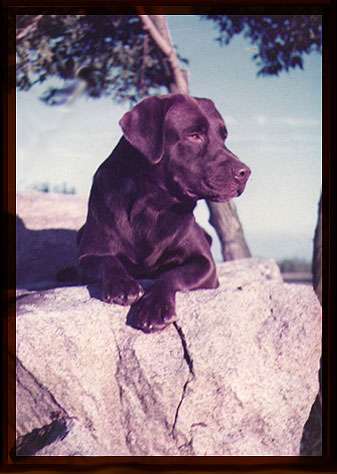
Castlemore Bramble
Gunfield’s Super Charger: route 8, via Shamrock Acres Super Drive, Super Chief, Paha Sapa Chief II, Freehaven Muscles, Grangemead Sharon.
Gunotter’s Chocolate Nip: route 5, via Harris Tweed of Ide and Sandylands Tweed of Blaircourt.
Haverhill’s Brown Belle: route 1, via Dickendall Flip Flop, Sandylands Midas and Reanacre Mallardhurn Thunder.
Ironwood Cocoa Mocha: route 8, via Del Tone Colvin, Cork of Oakwood Lane, Coastal Charger of Deer Creek, Little Pierre of Deer Creek.
Lawnwoods Chocolate Fudge: directly via route 2, and route 1 via Lawnwoods Tapestry and Reanacre Mallardhurn Thunder.
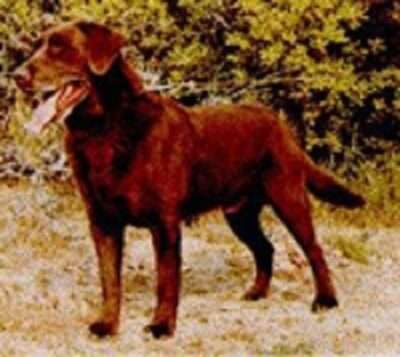
Gunfield’s Super Charger
Lawnwoods Hot Chocolate: route 2.
Lenches Chocolate Liquor: Route 1 via Lasgarn Ludovic and Sandylands Mark.
Loughderg Fiona: route 4, via Ruler of Blaircourt.
Marbra Leprechaun: route 2.
Pride of Craigavon: route 5.
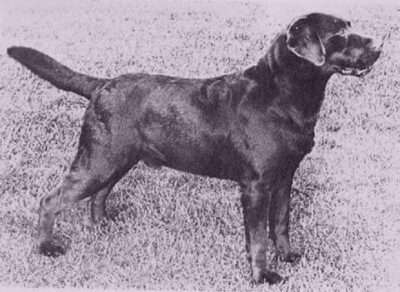
Lawnwoods Hot Chocolate
Pumerang Connection With Stormley: route 2, the easy way via Harrop Black Jack, or take the detour via Stormley Lynx with Pumerang, Ravenshall Charmer at Stormley, Clayford Music At Midnight At Stormley, Lawnwoods Midnight Folly and Lawnwoods Fandango.
Roydwood Rowntree at Ravenshall: route 1 and 2, via Keithray Lucinda, Contessa of Keithray and Sandylands Tandy.
Simandem Sam Browne of Balrion: route 2, via Charway Blackthorn of Follytower.
Sorbus Brown Jay: route 5, via Alvgardens Sam, Alvgardens Jet, Alvgardens Flap, Sandylands Twanah and Sandylands Tweed of Blaircourt.
Tracers Sweet Georgia Brown: route 2, via Follytower Chevalier of Ranfurly and Follytower Augusta.
Waltham Galaxy of Condor: route 1, via Jayncourt Stormer and Sandylands Mark.
Whisky Creek Brown Buina: route 4, via Indian Valley Raed Wulf and Bart of Blaircourt.
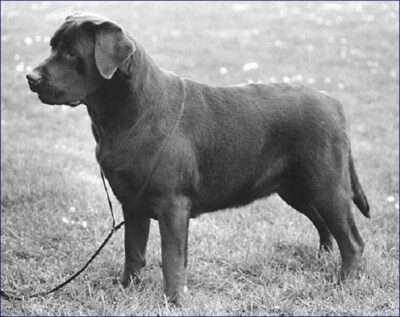
Pumerang Connection With Stormley
Williston Brown Smith: route 1, via Sebastian of Anderscroft, Sandylands Midas and Reanacre Mallardhurn Thunder.

Williston Brown Smith
I’m pretty sure that at least 99% of all chocolate Labradors can be categorized using one of the 8 routes above.
Several routes can be taken to track the origin of chocolate Labs.

Wetherlam Nutcracker, ancestor of most of my chocs.
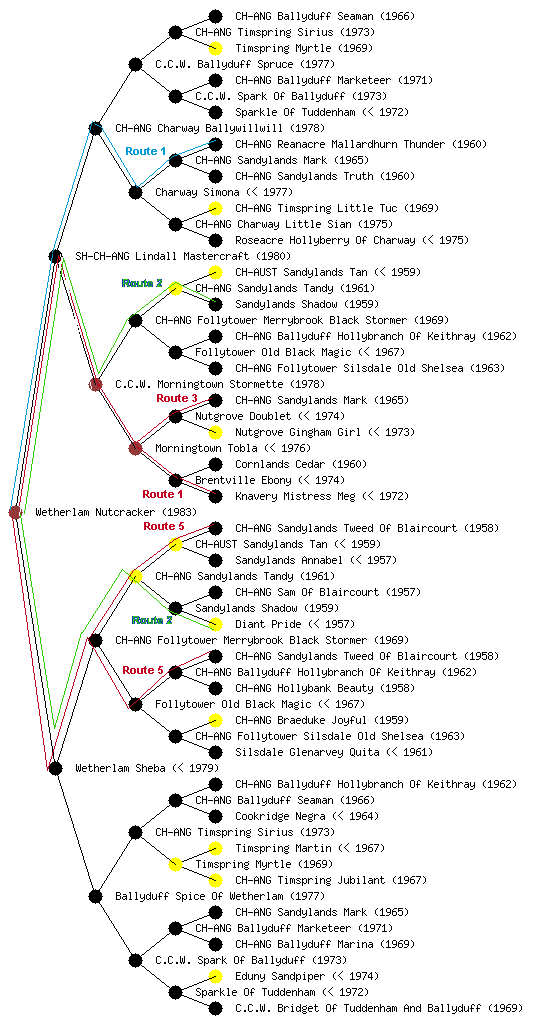
Jack Vanderwyk,
LabradorNet
May 5, 2003
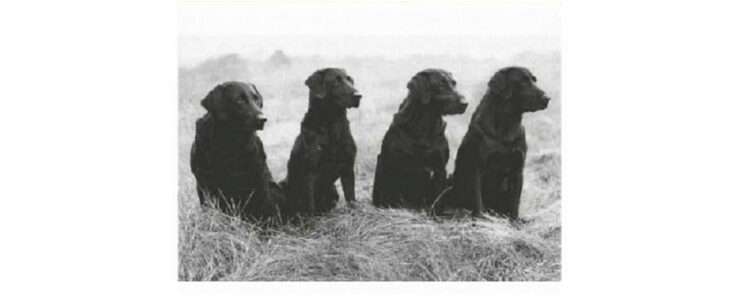
Not only one of 37 Labradors in the US to earn both a show and a field championship, but part of a dynasty. Four Dual Champions in four consecutive generations – 3xNFC CFC Dual CH Shed of Arden, father of Dual CH Grangemead Precocious, grandfather of Dual CH Cherokee Buck and great grandfather of Dual CH AFC Alpine Cherokee Rocket.
HIS BACKGROUND
Precocious was bred and owned by Thomas W. Merritt, a man who spent many years supporting the breed and competition he loved.
- Judged over 50 field trials, including the first National Amateur Stake in 1957 and the National Open (4 times).
- One of the original incorporators of the National Club.
- Past President of the Labrador Club.
- Was a Director of the American Kennel Club.
- President and Editor-in-Chief of the Retriever Field Trial News.
That’s in addition to breeding and owning some of the top Labs of the 1940s and 1950s. He reminds me of Lorna, Countess Howe in their efforts for the breed plus the great dogs they each owned.
Merritt mentioned one of his first puppies was Grangemead Angel who was sired by FC Freehaven Jay. Her mother was a granddaughter of Eng CH Banchory Trueman – another link to Lorna. He bred Angel to Am FC Eng FTCh Hiwood Mike who was a grandson of Eng Dual CH Banchory Painter, yet another link.
Grangemead Sharon, mother of Dual CH Cherokee Buck, was a puppy from the Angel x Mike litter.
HIS PEDIGREE
| 3xNFC CFC Dual CH Shed of Arden | CH Raffles of Earlsmoor | Thatch of Whitmore (Eng CCW) |
| Task of Whitmore (Eng CCW) | ||
| FC Decoy of Arden | Odds On (Eng FTW) | |
| Peggy of Shipton (Eng FTW) | ||
| Huron’s Lady | Am Eng CH Banchory Trump of Wingan | Blenheim Scamp (Eng FTW) |
| Lady Daphne | ||
| CH Bancstone Lorna of Wingan | Eng Dual CH Bramshaw Bob | |
| Eng CH Drinkstone Peg |
The Labrador Retriever was still pretty new to our shores at this time and all eight of Precocious’ great grandparents were British. Shed of Arden was sired by a British import and his maternal grandparents were both British imports. Precocious’ maternal grandparents were also British imports.

CH Raffles of Earlsmoor

3xNFC CFC Dual CH Shed of Arden

FC Decoy of Arden (right)

Banchory Trump of Wingan

Bancstone Lorna of Wingan
PRECOCIOUS GETS HIS START
He was born June 21, 1946, along with at least two litter brothers, Jock of Athabaska and Deer Creek Black Ace. Both brothers finished their show championships.
Merritt remembers Precocious as “a bigger dog than Shed. He was a good marking dog, especially in water and especially strong in water triples.” According to Helen Warwick in The Complete Labrador Retriever.
He was trained and handled by Harold Berentsen. He won his first Open stake at 28 months and finished his field championship about a year later.
During the summer of 1950 he became a show dog and often won Best of Breed. He even placed in the Group a couple of times. Admittedly entries were much smaller than they are today. He won his first Best of Breed on May 7, 1950 and finished his show championship on June 18, 1950. Having already finished his field championship, he became a Dual Champion that same day.
He qualified for and ran in four National Championships – 1948, 1949, 1950 and 1951. He was a finalist in 1950 and 1951.
HIS LEGACY
Some people say he was named Precocious because he sired his first litter at the age of six or seven months. Based on birth dates, he was actually a grand old pup of nine months when he did the deed.
But what a deed! In that one litter with Grangemead Sharon he sired:
DUAL CH CHEROKEE BUCK
– sire of Dual CH AFC Alpine Cherokee Buck
— grandsire of NAFC FC Andy’s Partner Pete
– sire of Ironwood Cherokee Chica
— grandsire of NFC 2xNAFC Super Chief (Hall of Fame), FC AFC Carr-Lab Penrod, FC Chief Black Feather, FC AFC Paha Sapa Warpaint, FC AFC Paha’s Pow-Wow, Spring Farms Lucky QAA
– sire of Luscious Licorice Lass
— grandsire of FC AFC CFC Triple Echo
FC CHEROKEE MEDICINE MAN
FC FREEHAVEN MUSCLES
– sire of FC AFC Paha Sapa Chief II (Hall of Fame)
— grandsire of NFC 2xNAFC Super Chief (Hall of Fame), FC AFC Carr-Lab Penrod, FC Chief Black Feather, FC AFC Paha Sapa Warpaint, FC AFC Paha’s Pow-Wow, Spring Farms Lucky QAA
— grandsire of NAFC FC Rebel Chief of Heber (Hall of Fame) and AFC Jilly Girl
– sire of FC Nelgard’s Counter Point
— grandsire of Dual CH CFC Ridgewood’s Playboy and FC AFC Sand Gold Kim
You can see these boys in the header image – left to right – Grangemead Precocious, Freehaven Muscles, Cherokee Medicine Man and Cherokee Buck.
Unfortunately Grangemead Sharon was given away before her sons were able to prove themselves. Who knows if a second litter of Precocious x Sharon would have equaled or bested the first litter.
Other offspring:
– sire of CFC Highlander’s Buccaneer and CAN CH Highlander’s Diana
— grandsire of Can Dual CH Blyth’s Knave of Spades
– sire of Beautywood’s Creole Jane
— grandsire of Don’s Ginny Soo
— great grandsire of 2xNAFC 3xCNFC FC River Oaks Corky (Hall of Fame)
— grandsire of FC Roy’s Rowdy
And, yes, we have a bit of Precocious in our dogs. Our pretty Dee and all her offspring, including Arwen, Tory and Cotti, trace back to Precocious several times.
1 – Through 2xNAFC FC River Oaks Rascal to Beautywood’s Creole Jane to Precocious
2 – Through 2xNAFC FC River Oaks Rascal to Dual CH AFC Alpine Cherokee Rocket to Precocious
3 – Through Shamrock Acres Juego De Azar to FC Freehaven Muscles AND Dual CH Cherokee Buck to Precocious
4 – FC AFC Raider’s Piper Cub to FC AFC Paha Sapa Chief II to Precocious
5 – Timberlane Cinnamon to 2xNAFC 3xCNFC FC River Oaks Corky to Precocious
6 – Timberlane Cinnamon to Black Beauty of Random Lake to FC Freehaven Muscles to Precocious
7 – Timberland Cinnamon to Muscle Man of Random Lake to Rise and Shine at Duckwind to Precocious
8 – Timberland Cinnamon to Cherokee King Bojo to Precocious
9 – Timberland Cinnamon to Luscious Licorice Lass to Precocious
10 – FC AFC CFC Trieven Thunderhead to FC AFC Paha Sapa Chief II to Precocious
11 – FC AFC CFC Trieven Thunderhead to Ironwood Cherokee Chica to Precocious
12 – FC AFC CFC Trieven Thunderhead to AFC Jilly Girl to Precocious
13 – Dale’s Double Hope to Dual CH CFC Ridgewood Playboy to Precocious
14 – Dale’s Double Hope to FC AFC Serrana Sootana of Genesee to Precocious
15 – Dale’s Double Hope to FC AFC Toni’s Tar to Precocious
16 – Dale’s Double Hope to Ebony Sally of Widgeon Bay to Precocious
17 – Hard Driving Abigail to Cherokee King Bojo to Precocious (twice)
18 – Hard Driving Abigail to Luscious Licorice Lass to Precocious
And Chip too goes back to Precocious. Through Jilly Girl (twice), Beautywood’s Creole Jane (9x), Super Chief (twice), Gunfield’s Super Charger, Paha Sapa Chief II (separate from Super Chief) and Howmor’s Dark Gypsy.
DUAL CH Grangemeade Precocious
Whelped: June 21, 1946
Breeder: Thomas W. Merritt
Registration: S-127563
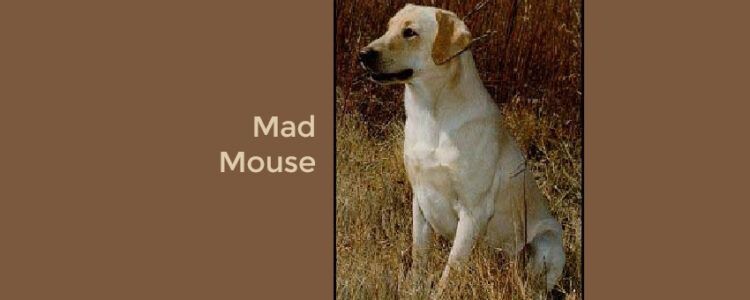
Mouse. What a name for a Labrador.
It’s memorable. Probably a good thing for a Hall of Fame dog.
I love the story of how Charlie and Yvonne Hays acquired him. They saw him in South Carolina when he was a young dog chasing fun bumpers. He beat his kennel mates to the bumpers and Charlie was so impressed he offered to buy him. The owner told him that he thought he was sold and the check should be in the mail.
So Charlie asked, “Mind if I check the mailbox?”
HIS HISTORY
Born on Christmas day in 1973, Candlewoods Mad Mouse qualified for and ran in his first National Open as a TWO year old. He was not yet titled, but made it to the seventh series handled by his owner. He finished both FC and AFC titles the following year.
He won a double header – winning both the Open and Amateur stake in the same trial.
He qualified for eight National Amateur trials and was a finalist in four. He also qualified for six National Open trials and competed in five. At the time of his death, he was the all-time high point yellow Labrador.
Mouse also ran field trials in Canada where he earned his CFC and CAFC as well.
In 1994 he was inducted into the Hall of Fame.
Mouse died in October 1984. He “… was known for his intelligence and his wagging tail. He was both a great field trial dog and a wonderful house pet.”
HIS PEDIGREE
| 2xNAFC FC River Oaks Rascal (Hall of Fame) | 2xNAFC 3xCNFC FC River Oaks Corky (Hall of Fame) | FC Martens Mister Nifty |
| Don’s Ginny Soo | ||
| Random Rapscallion | FC CFC Duxbak Scooter (Hall of Fame) | |
| Random Shot | ||
| Shamrock Acres Duck Soup | NFC 2xNAFC Super Chief (Hall of Fame) | FC AFC Paha Sapa Chief II (Hall of Fame) |
| Ironwood Cherokee Chica | ||
| Shamrock Acres Smoke Screen | NFC FC Marten’s Little Smoky | |
| Shamrock Acres Starlight |
Mouse was inducted into the Hall of Fame, as were his father, both grandfathers and two of his great grandfathers. Also four of the dogs in his three-generation pedigree were National Champions, some winning multiple times.
His Father
2xNAFC FC River Oaks Rascal
Hall of Fame
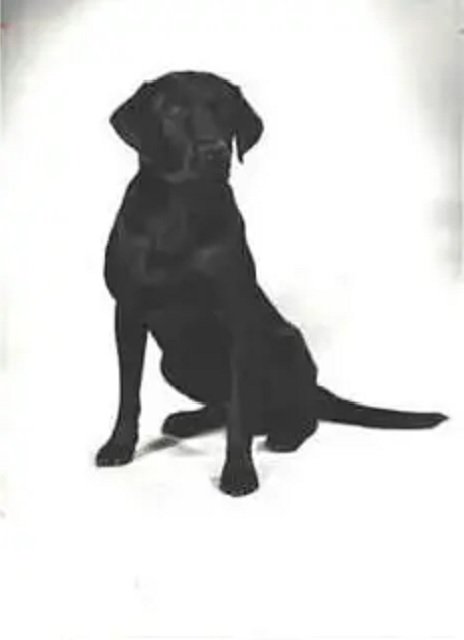
His Paternal Grandfather
2xNAFC 3xCNFC FC River Oaks Corky
Hall of Fame
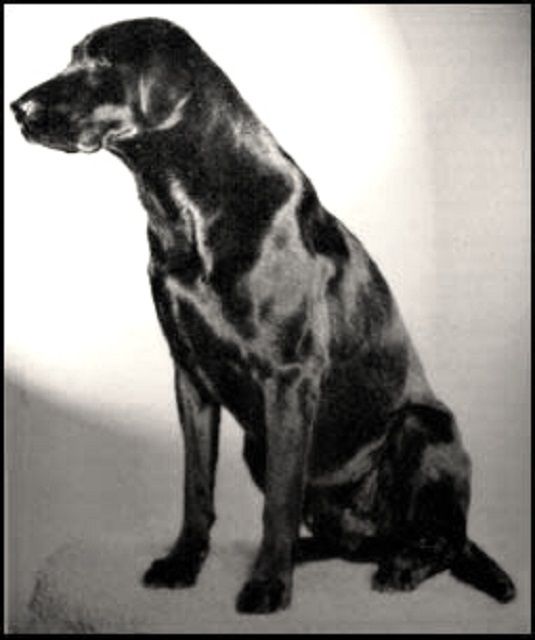
His Maternal Grandfather
NFC 2xNAFC Super Chief
Hall of Fame
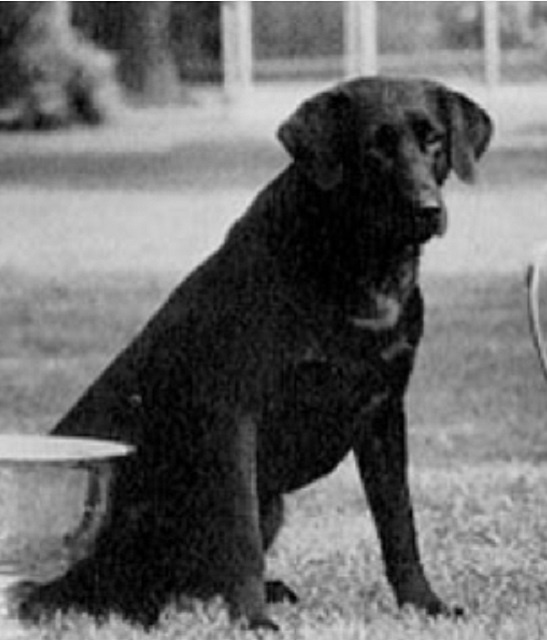
By the way, for those of you who know I’m fascinated with the DUAL CHAMPIONS, here’s who shows up just a bit farther back in Mouse’s pedigree.
- Martens Mister Nifty was a great grandson (and great great grandson) of Can DUAL CH Coastal Charger of Deer Creek.
- Don’s Ginny Soo was a granddaughter of DUAL CH Grangemead Precocious (by 3xNFC CFC DUAL CH Shed of Arden).
- Random Shot was sired by DUAL CH AFC Alpine Cherokee Rocket (by DUAL CH Cherokee Buck by DUAL CH Grangemead Precocious by 3xNFC CFC DUAL CH Shed of Arden).
- Paha-Sapa Chief was a grandson of DUAL CH Grangemead Precocious (by 3xNFC CFC DUAL CH Shed of Arden).
- Ironwood Cherokee Chica was sired by DUAL CH Cherokee Buck (by DUAL CH Grangemead Precocious by 3xNFC CFC DUAL CH Shed of Arden). And she was out of a granddaughter of Can DUAL CH Coastal Charger of Deer Creek.
- Marten’s Little Smoky was a great grandson of DUAL CH Grangemead Precocious.
- Shamrock Acres Starlight was a grand daughter of DUAL CH Dela-Winn’s Tar of Craignook (a little known DC).
Although not a DUAL CH, Duxbak Scooter’s grandmother was Eng Can CH Sandylands Jilly who is also an ancestor of Ebonstar Lean Mac (among others).
HIS OFFSPRING
- FC AFC Hellda Dolly (ex Ishtar’s Raider)
- AFC Kizzie of Southern Comfort (ex Agassiz Shores Coli-Ann CD)
- AFC CAFC Minnie Mouse (ex Belmars Black Castle) When Minnie was bred to AFC Westwinds Pedro, they produced CNFC CNAFC FC AFC The Marathon Man (Hall of Fame).
Mouse’s line continues through yet another daughter, BJ’s Crystal Light Brigade (out of BJ’s Dawn of Early Morning, a show-bred bitch of mostly Shamrock Acres breeding). And their daughter, Floodbay’s Caramel Crystal WCX (by FC AFC CNAFC CFC Gunstock’s Caramel Crunch) and their daughter, Clubmead’s Dark Crystal JH (by FC AFC CFC CAFC DB’s Cracker of Club Mead). Dark Crystal, better known as “Raven,” was a dog I owned. When bred to BISS Am Mex CH GMHR Cook’s Midnight Bandit MH, she produced Justamere Canis Major JH and Justamere Catalyst RA CGC CC. Many more dogs descend from these two littermates.
Another link to Mouse is through his 3/4 brother, FC AFC Canis Major’s River Bear. Bear was also sired by Rascal and out of a daughter of Super Chief. In turn, he was the sire of FC AFC River Oaks Way-Da-Go Rocky who figured prominently in our early dogs, including Arwen, Tory and Cotti, through his daughter Dee.
FC AFC CFC CAFC Candlewoods Mad Mouse
Yellow Labrador male
Breeder: Mary Howley (Candlewood)
Owner: Charlie and Yvonne Hays
Born: Dec 25, 1973
Died: Oct 1984
Registration: SB538973
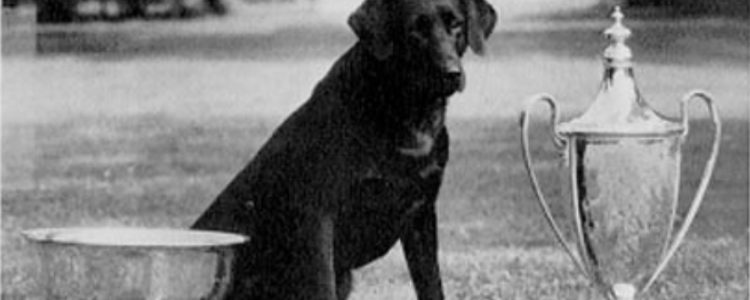
What makes a great dog? Is it genetics? Is it the way he’s raised? Is it due to training? Is it due to handling? Or is it all of the above? NFC 2xNAFC Super Chief would probably say all of the above.
SUPER CHIEF’S FORMULA FOR SUCCESS
Born in 1962, Soupy was given to August “Augie” Belmont IV by his breeder because a previous dog from the breeder had turned out unsound. The Belmonts raised Soupy on Long Island until he was six months old.
Training Greatness
At that time, Soupy was old enough to begin serious training, so Augie flew him to Rex Carr in California. Carr is called “the father of modern retriever training.”
To be trained by a legend would definitely help a dog achieve greatness.
Handling Expertise
Rex Carr often trained the owners to handle their own dogs – a task that’s probably more difficult than training the dogs. It must have worked though as Augie and his wife, Louise, handled Soupy to many field trial wins. Starting with five Derby wins by 19 months, Soupy won 40 Derby points, 112 Amateur points and 242 Open points. He also won the 1967 and 1968 National Amateur Retriever championship plus the 1968 National Retriever championship.
Soupy had a good trainer and good handlers.
Superb Genetics
What about genetics? His parents were both grandchildren of DUAL CH Grangemead Precocious. Precocious was sired by 3xNFC CFC DUAL CH Shed of Arden out of Huron’s Lady – a mixture of show, field and dual champions.
Add in two crosses each to:
- Am Eng FC Hiwood Mike
- DUAL CH CFC Little Pierre of Deer Creek
- NFC AFC Marvadel Black Gum
- Can DUAL CH Coastal Charger of Deer Creek
Plus NFC AFC CFC Cork of Oakwood Lane and NFC Tar of Arden.
Plus more Dual Champions – DUAL CH Cherokee Buck and DUAL CH NFC CFC Bracken’s Sweep.
Plus a line that includes dogs from the Sandylands show kennel through FC The Spider of Kingswere.
| FC AFC Paha-Sapa Chief II | FC Freehaven Muscles | DUAL CH Grangemead Precocious |
| Grangemead Sharon | ||
| Treasure State Bewise *** | FC The Spider of Kingswere | |
| FC Deer Creek’s Bewise | ||
| Ironwood Cherokee Chica | DUAL CH Cherokee Buck | DUAL CH Grangemead Precocious |
| Grangemead Sharon | ||
| Glen-Water Fantom | NFC AFC CFC Cork of Oakwood Lane | |
| Little Peggy Black Gum |
Click to see his 5-generation pedigree.
DESCENDANTS
Soupy was bred to a variety of bitches, some with field breeding, but also to some with show breeding. Between his pedigree and his offspring, I’d say he also had good genetics.
Some of his offspring include:
* DUAL CH Shamrock Acres Super Drive
Sire of Am Mex CH Gunfield’s Super Charger CD WC who did much to improve chocolates
* DUAL CH Royal Oaks Jill of Burgundy 2005 Hall of Fame
* NFC NAFC 2xCNFC Wanapum Darts Dandy 1992 Hall of Fame
* FC AFC Air Express
Sire of many field champions, including FC AFC Itchin’ To Go, CNFC FC Overland Express, FC AFC CFC Trieven Thunderhead, FC AFC CFC CAFC Wanapum Super Sioux, NAFC FC Winsom Cargo and DUAL CH AFC Trumarc’s Triple Threat
* FC AFC Candlewood’s Nellie B Good
Granddam of FC AFC Wilderness Harley To Go 2003 Hall of Fame and FC AFC Candlewoods M D Houston 1996 Hall of Fame
* NFC FC AFC Euroclydon (pronounced u-roc-li-don)
1993 Hall of Fame and dam of NFC FC AFC Orion’s Sky 1994 Hall of Fame
* FC Candlewood’s Super Deal
Grandsire of 3xNFC FC AFC Candlewood’s Tanks A Lot
* Super Powder QAA
Sire of NFC AFC FTCH Risky Business Ruby 1993 Hall of Fame and FC AFC Volwood’s Ruff And Reddy 2000 Hall of Fame plus grandsire of FC AFC Code Blue 2000 Hall of Fame and FC AFC CNFC CAFC Chena River No Surprise 2004 Hall of Fame
* Shamrock Acres Juego de Azar
Granddam of FC AFC River Oaks Way-Da-Go Rocky who was the sire of our Knight’s Tail Dehlia.
* Shamrock Acres Super Sioux
Dam of FC AFC Raider’s Piper Cub
* Sirion’s Super Snooper
Dam of CFC Rascal’s Super Spud who sired CNFC CNAFC Waldorf’s High Tech who sired 2xNAFC 2xCNAFC FC CFC Ebonstar Lean Mac
* Paha Sapa Greta
Dam of FC AFC Ironwood Tarnation 1995 Hall of Fame
* Cup A Soup
Dam of NFC AFC CFC CAFC Yankee Independence
* FC Shamrock Acres Super Value 1998 Hall of Fame
* Shamrock Acres Duck Soup
Dam of FC AFC CFC CAFC Candlewoods Mad Mouse 1994 Hall of Fame
* FC Wanapum Sheba
Dam of NAFC FC Kannonball Kate 1992 Hall of Fame
And several more titled offspring.
Is Soupy in our pedigrees? Yes, many times.
- Chip and all of his descendants trace to him through DUAL CH Shamrock Acres Super Drive (12 times!) and CH Gunfields Super Charger CD, DUAL CH Trumarc’s Triple Threat, FC AFC Air Express, FC AFC CFC Trieven Thunderhead, FC AFC Candlewood’s Nellie Be Good, CH K’s Jetta of Someday, AFC Shamrock Acres Whiskey Jake
- Dee and her descendants trace to him through FC AFC Canis Major’s River Bear
- Cat and her descendants trace to him through 2xNAFC 2xCNAFC FC CFC Ebonstar Lean Mac, CNFC CNAFC FC AFC The Marathon Man, FC AFC CFC CAFC Candlewoods Mad Mouse (twice) and NFC FC AFC Westwind Supernova Chief
By the way, if you follow horse racing you’ll recognize the family name. Although Augie also owned race horses, he was not as active as his grandfather, August Belmont II, or great grandfather, August Belmont, who founded Belmont Park and for whom the Triple Crown race was named.
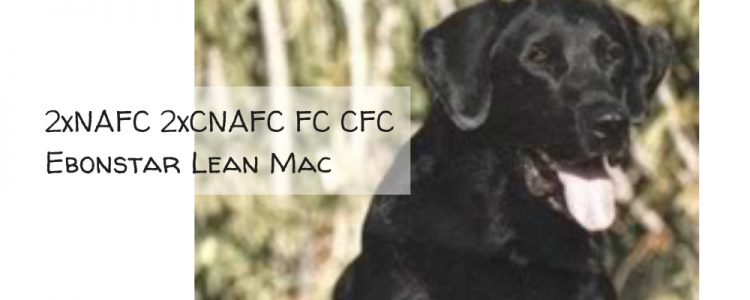
Out of curiosity, I looked into the pedigree of 2xNAFC 2xCNAFC FC CFC Ebonstar Lean Mac who was probably the most influential field Labrador Retriever in recent history.
Why was he so influential?
He earned a Field Championship (FC) and an Amateur Field Championship (AFC) in BOTH the US and Canada.
He also won the National Amateur Field Championship (NAFC) twice and he won the Canadian National Amateur Field Championship (CNAFC) twice. (Learn more about title abbreviations.)
And he produced many dogs who earned hunt test titles, field championships and won more national championships.
But today we’re going to look at some of his ancestors. So who does he descend from?
Here’s his 3-generation pedigree:
| CNFC CNAFC Waldorf’s High Tech | CFC Rascal’s Super Spud | NAFC FC Ray’s Rascal |
| Sirion’s Super Snooper | ||
| Itch’s Flying Tiger | FC AFC Itchin’ To Go | |
| Thor’s Tiger Lillie | ||
| Ebonaceae Princess WCX QAA | Trieven El Conquistador | FC AFC CFC Trieven Thunderhead |
| Trieven High Speed | ||
| Skookum’s Sky Raider | CFC CAFC Virdon’s Tuktoyaktuk | |
| Wilkie’s Cinderella Liberty |
It’s when you go back further that you find ancestors some people might find surprising –
3xNFC CFC DUAL CH Shed of Arden (19)
DUAL CH Matchmaker for Deer Creek (4) – and his sire and grandsire:
DUAL CH CFC Little Pierre of Deer Creek (15)
Am Eng CH Banchory Trump of Wingan (4)
DUAL CH Cherokee Buck (6) – and his sire:
DUAL CH Grangemead Precocious (12)
Can DUAL CH Coastal Charger of Deer Creek (16) (another son of Little Pierre)
NFC DUAL CH CFC Bracken Sweep (8)
CH Whygin Poppitt (3)
Can DUAL CH Dart of Netley Creek (3)
FTCH CAN DUAL CH Treveilyr Swift (1)
Eng Can CH Sandylands Jilly (1)
DUAL CH CFC Ridgewood Playboy (1)
DUAL CH AFC Hello Joe of Rocheltree (1)
CNFC CAN DUAL CH AFC Stormy Of Spirit Lake Gal (1)
ENG DUAL CH Staindrop Saighdear (1)
CAN DUAL CH CAFC Netley Creek’s Black Drake (1)
(The numbers following the names are the number of times that dog shows up in his 10 generation pedigree.)
Maxx is very well known in the field trial and hunt test communities, but many people don’t realize how many SHOW DOGS are in his pedigree.
To be fair, many of these dogs lived during a time when Labs competed in both field trials and dog shows and could earn championships in both. There hasn’t been a DUAL CHAMPION Labrador since the 1980s though.
There are also numerous FC, AFC, NFC and NAFC dogs, such as NFC 2xNAFC Super Chief, NAFC FC CFC Guy’s Bitterroot Lucky, NFC AFC Massie’s Sassy Boots, Eng IGL CH FTCH Glenhead Zuider, NFC AFC CFC Cork of Oakwood Lane, NAFC FC Ray’s Rascal, NFC AFC Marvadel Black Gum.
I had two of Maxx’s granddaughters, including Clubmead’s Dark Crystal, and many of my current dogs descend from her. While her pedigree has several American and Canadian FC and AFCs, plus a healthy dose of National Field Champions, if you follow her maternal line you’ll find some show dogs in her pedigree too. One top dog – AM CAN CH Shamrock Acres Light Brigade – shows up three times. By the way, CH Whygin Poppitt, who shows up in Maxx’s pedigree, is also the grandsire of Light Brigade.
It wasn’t that long ago Labradors came from one gene pool. There weren’t “American” Labs or “English” Labs, they were all just Labrador Retrievers.
Does that make you stop and think about recent breeding choices?


